We continue on our travels through South America, including visting the Pantanal in Brazil, Iguacu falls in Argentina, Ciudad del Este in Paraguay and then off to Samaipata in Bolivia.
4 July, Canoa Quebrada
We got a room without breakfast included, so we decided to use the opportunity to sleep late instead of being woken by an alarm clock. At about 12 am we went down to the local (very basic) bar/restaurant for some Churrascuro (grilled meat and side dishes) at R$ 10 per person (about €4.50). It’s been 6 weeks without any stomach problems or diarrhea. This includes eating from street stalls, bus stations and from makeshift “home” restaurants (sometimes in people’s living rooms).
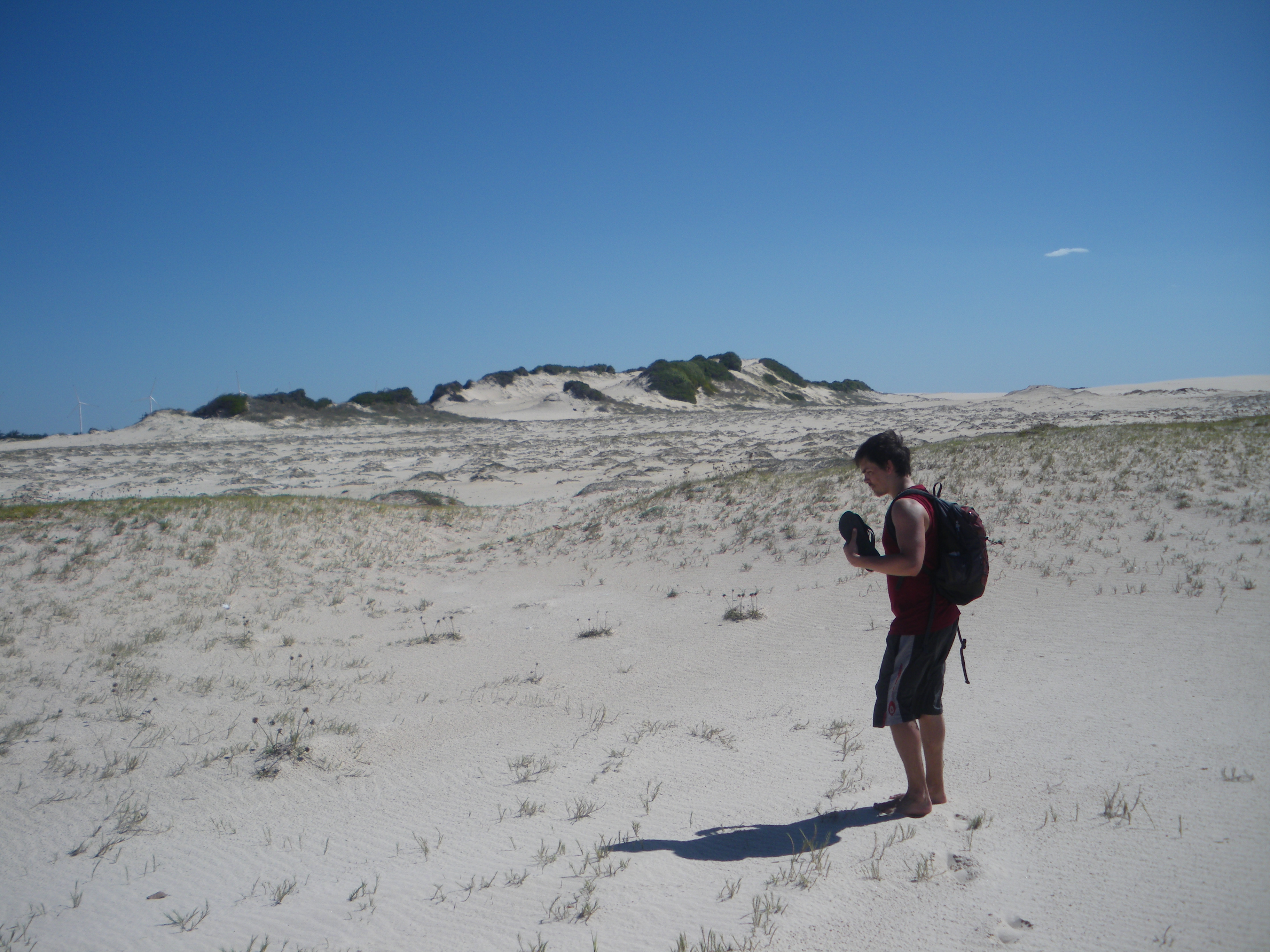
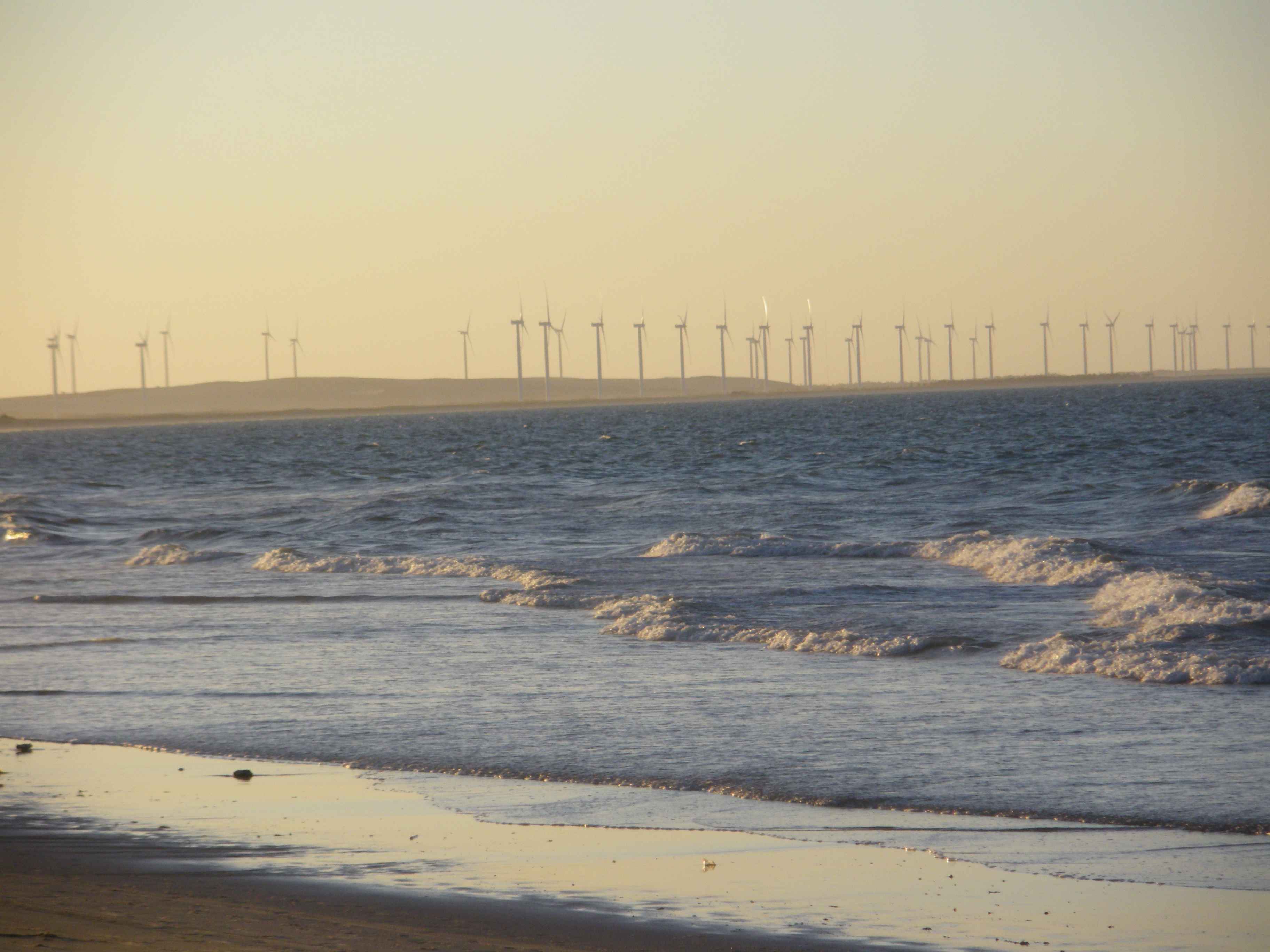
We then went to the main beach, quickly saw that it was too crowded for us, turned left and started walking to a collection of electric windmills off in the distance. Canoa’s beach is quite long, a local estimated about 20 km in total, with the main beach occupying only about 150m, so we had a long stretch of deserted beach to explore.
I expressed my desire to to go and stand under one of the windturbines so we continued walking along the coast into their direction. After about almost two hours of walking in the midday sun we concluded that these things were still deceptively far away, and that we must get some rest soon. To make matters worse, we only had 500ml of water with us. I eventually found a new target to make all the walking worthwhile and we headed off to a sanddune nearby to look for some shade.
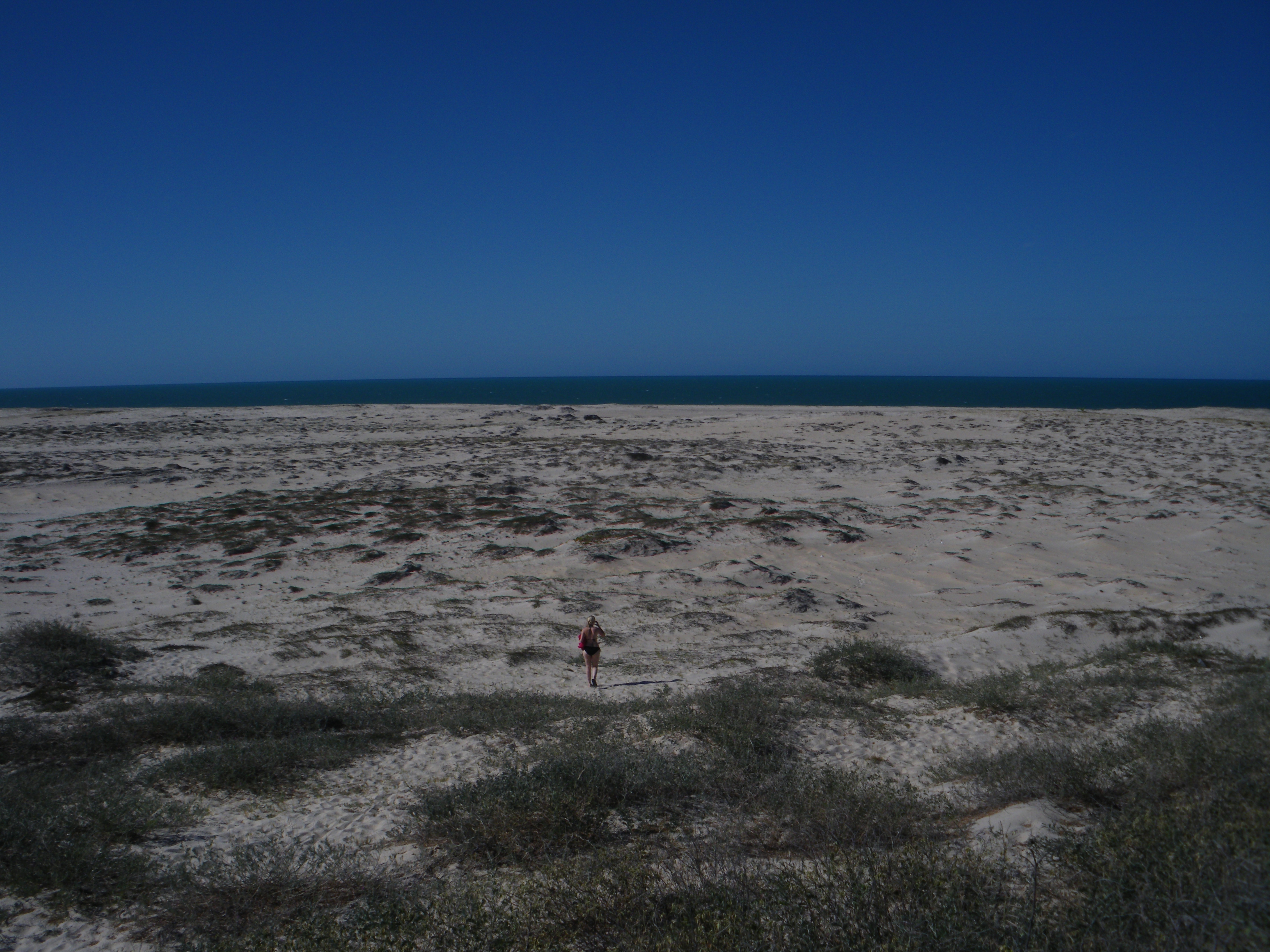
Canoa Quebrada is very reminiscent of Swakopmund in Namibia. It’s very hot and dry with a long stretch of coast flanked with white sanddunes. Very pretty in it’s own way. We were unfortunately quite sad to see plastic litter across the entire stretch of beach that we walked. To make matters worse, we found several dead fishes and puddles of brown and clearly polluted water. One of the big touristic selling points in Canoa is the buggy rides to the sanddunes. Every 15 minutes a buggy with smiling people would pass us by as we walked along the coast and practically the entire stretch of beach was turned into a buggy highway covered in tire tracks. As a result we were a bit disappointed with Canoa Quebrada. It seems the residents still need to develop a sense of responsibility for conserving the beaches fragile ecosystem and for keeping it clean.
6 July Overnighting at Fortaleza airport
Our plane from Fortaleza to Campo Grande left at 6:00 in the morning, so we made the decision to stay the night at the airport.
At about 12:00 at night, we made a little campsite under the stairs of the viewing hall and got ready to tuck in. Manuela successfully slept there for about an hour, but about half an hour after I joined, a security guard came and politely asked us to leave. That was pretty much our only chance for sleeping that night, so for the remainder we sat on some (probably purposefully) uncomfortable chairs listening to music and trying to catch some minutes of sleep before being woken up by the inevitable pins and needles in the butt cheek and leg that bore the brunt of the body’s weight.
7 July, Campo Grande
We arrived in Campo Grande at about 12 in the afternoon. Hungry and exhausted. We met a Danish couple and the four of us were quickly roped in by a smooth talking Pantanal tour salesman named Gil.
Gil fired off his sales pitch at our fragile, sleep deprived minds. We were all wary of being ripped off and trying to be intelligent, discerning tourists, but eventually the prospect of going downtown alone with our backpacks to look for a better deal looked less and less appealing. Gil continued, showing us pictures of a Pantanal lodge with reclining beach chairs, swimming pool, dormitories and private rooms and then when our defenses finally broke, went ahead and sold us a package that excluded all of the above. Without explicitly telling us of course.
9 July, Santa Clara lodge, Pantanal
The first morning of our stay in the Pantanal, we had to be ready at 4 o’clock to go on an early morning game drive.
The Pantanal is 90% private owned, so we had to restrict ourselves mostly to the big public gravel road that moves between the farms, which felt less immersive in the wild than the game drives I’ve been on in South Africa. This was one of a few times that the thought occurred that it’s quite a shame that there is no big national park in the Pantanal, such as Etosha in Namibia or Kruger Park in South Africa.
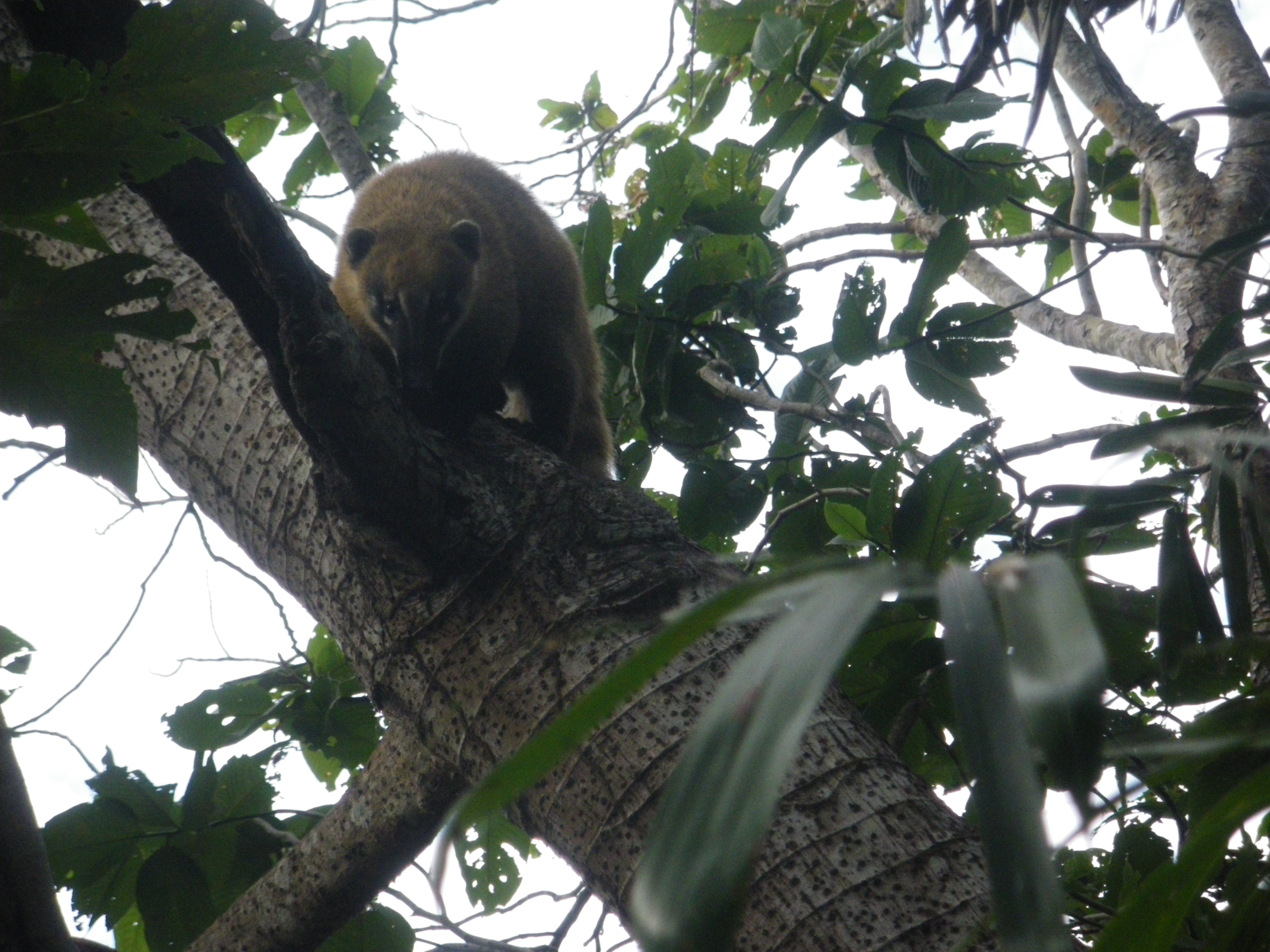
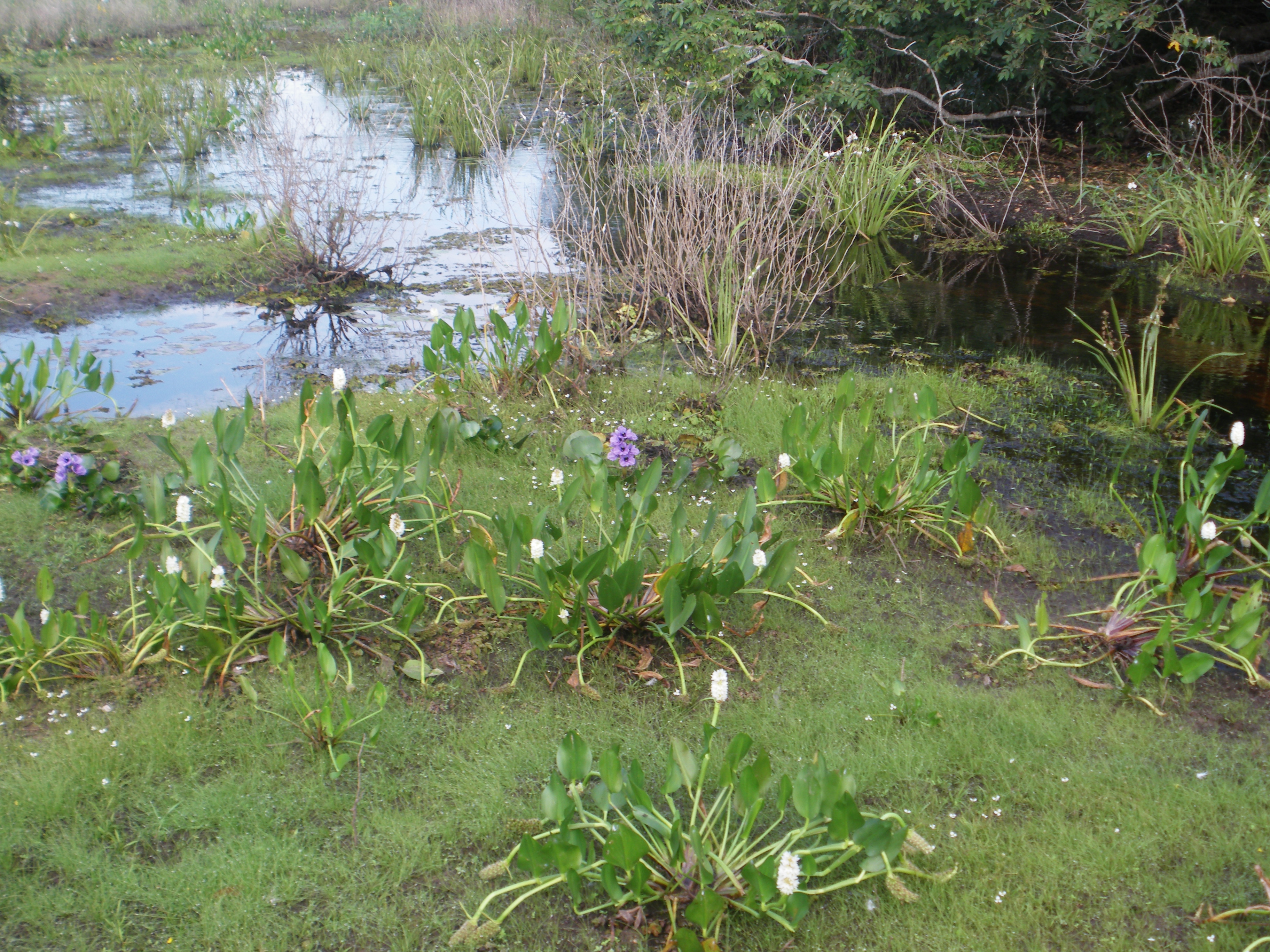
For brevity, I’ll refrain from overly describing this amazing place, and instead the inquisitive reader to the wikipedia page. Some interesting facts that I can’t help mentioning though, are that the entire Pantanal covers an area the size of France and contains about 35 million caimans (alligators) and a stunning collection of birds and other wildlife. Pantanal means swamp, and during the rainy (summer) season, almost the entire place gets covered in water. During the dry months, only a limited amount of swamps remain though, with lots of dry bushveld in between.
Our guide for the early morning trip was exceptional. In the dim light of dawn he spotted birds in trees and even small spiders in the road. Sometimes it took me half a minute to spot a bird that he recognised minutes before in a moving vehicle.
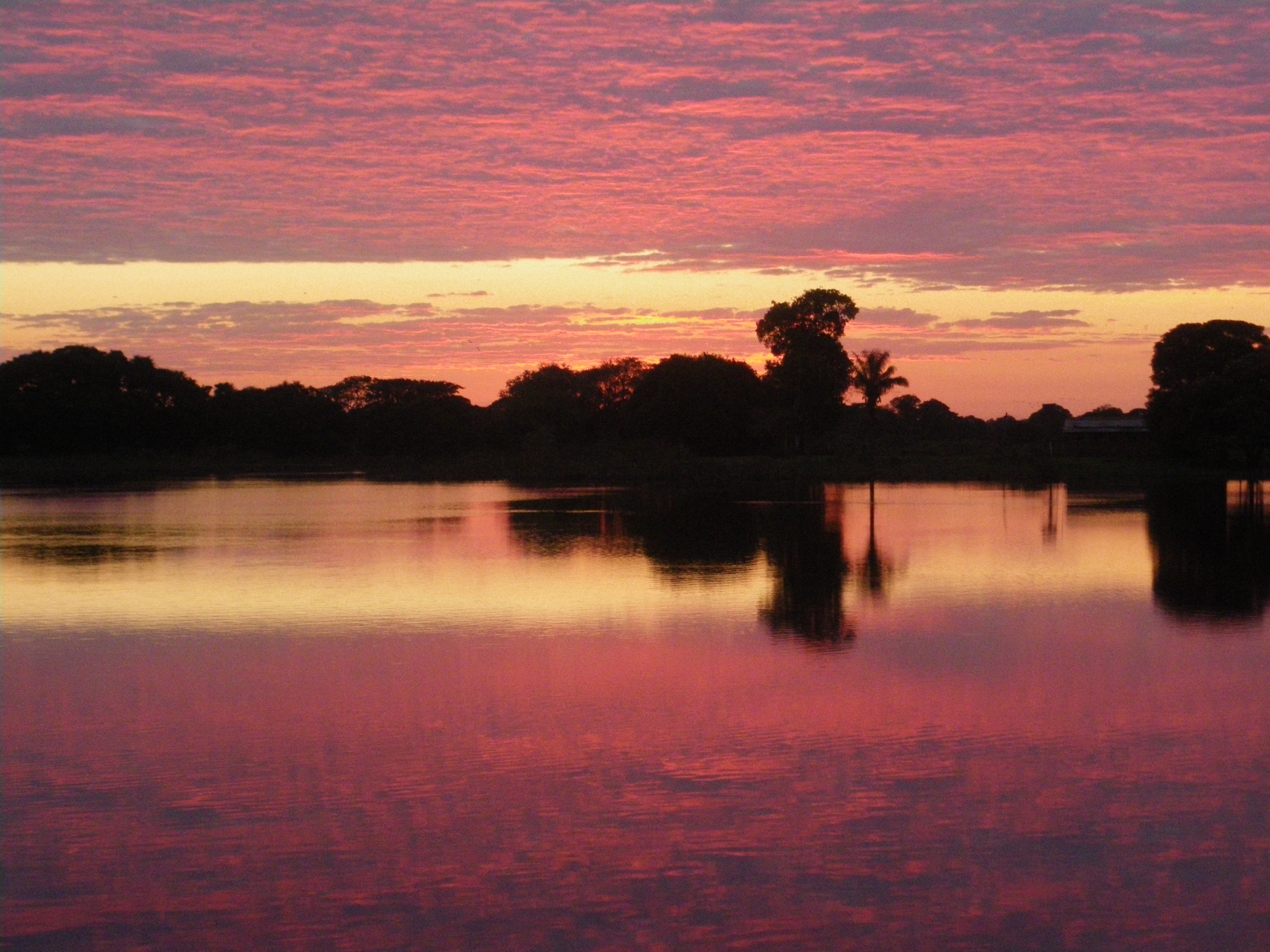
Overall we spent about 6 hours in the bush, which included watching a spectacular sunrise over a lake, followed up by a hike for about 2 hours.
We saw quite a few animals, a local raccoon, small bush deer, large deer, some more caimans, black howler monkeys, a large and scary tarantula like spider and a variety of birds.
The afternoon was spent horse-riding. What could be said about that? Well, it was great, I could get used to a lifestyle of regular horse-riding and I felt a special kinship with my specific horse, even though it was a bit of a tourist whore. It made some strange grunting and burping noises during the ride, which prompted various theories from our group as to their origin, randing from the mundane, to sexual to esoteric.
10 July, Santa Clara lodge, Pantanal
The nights we slept in hammocks in the open air (surrounded with mosquito nets), and were woken up that morning by the sounds of the wild. Loudest of all was the call of a bird called the Chacochachalaka, whose name is an onomatopedic attempt to recreate this creature’s cacophonic call but which ultimately fails. The noise is usually created by at least two birds in tandem. The one starts making a more high pitched call, then immediately followed by a lower pitched reply. The aural effect is a bit similar to a recording of a chicken being grabbed by the neck and swung around a few times, with the pitch lowered a few octaves.
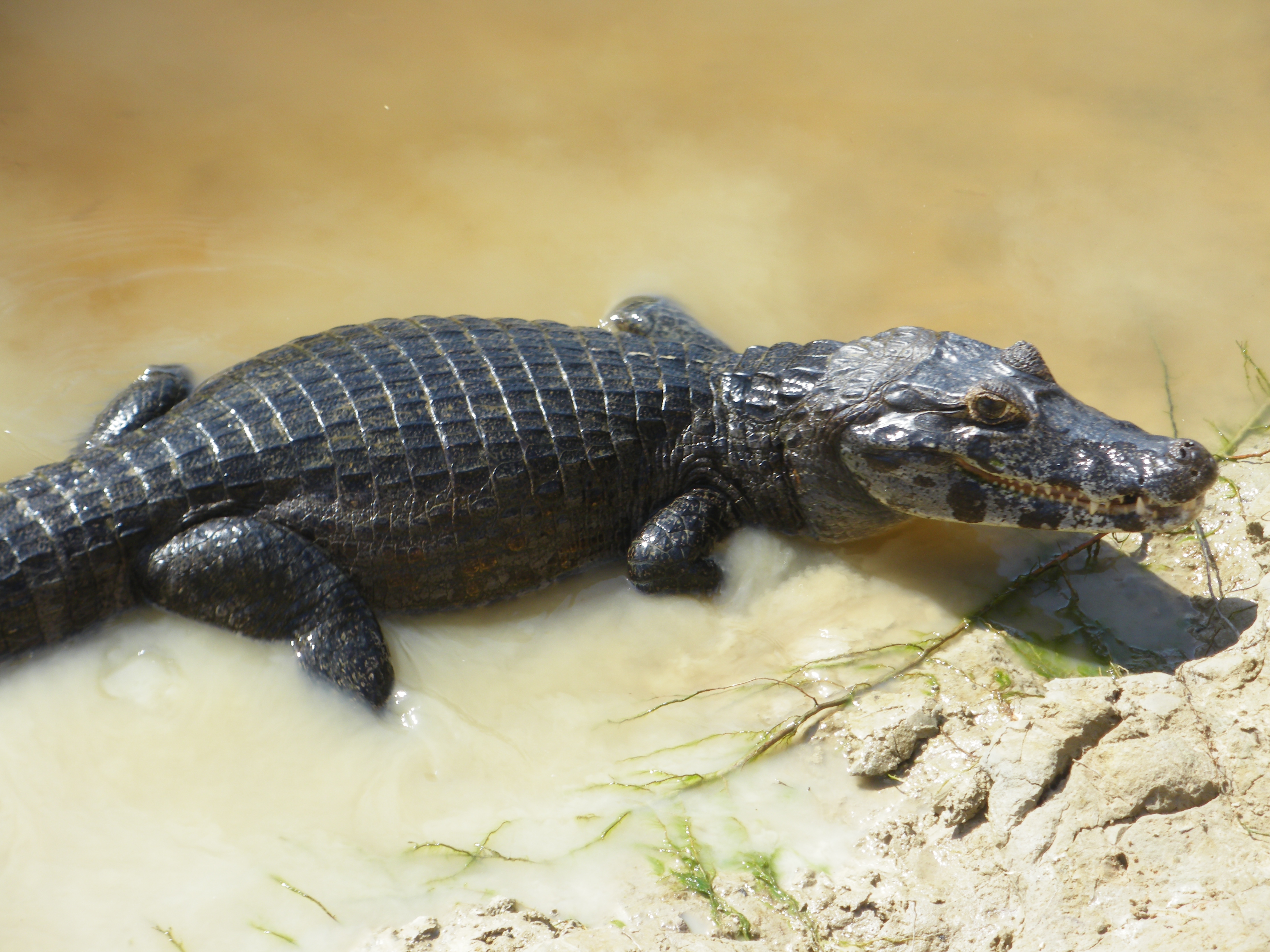
For the morning activity, we went on a boat ride on the local river, a tributary of the Paraguay river. We got a chance to see even more Caimans, some Capivaras and another large variety of birds.
The afternoon was spent piranha fishing with little peaces of beef, a surprisingly easy and fun activity. Manuela had one of the biggest catches of the day, I caught about 5 piranhas, with 3 being let go for being too small to do anything useful with.
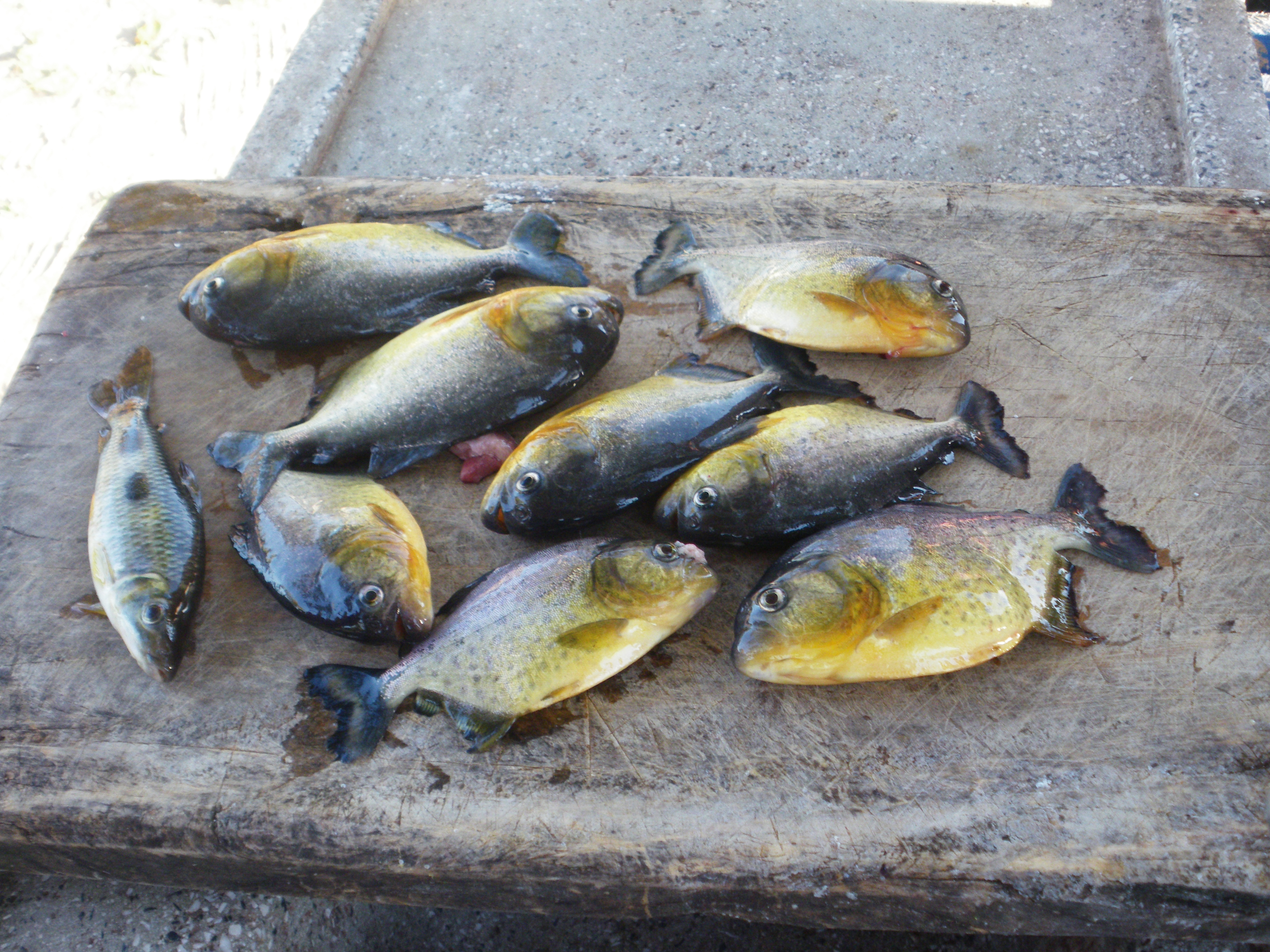
Later, while we were cleaning the fish, our guide cut out the tiny heart of a dead piranha. To my amazement, it was still beating! Our guide remarked that perhaps that’s why the piranhas are such nasty fish, they have very small hearts. I held the beating heart in my palm for a few minutes, considering wether I should eat it, but eventually threw it away. The piranhas have very sharp teeth, capabale of biting off a finger, even after they’re dead (due to convulsions), but the concept of people being attacked and killed by piranhas is a myth. We swam in the caiman and piranha infested waters and lived to tell the tale. Piranhas will only attack if you are bleeding and caimans eat only fish. So even though both animals are still dangerous and can definitely injure a person badly, it’s still quite safe to swim in the river if you maintain a distance and avoid any bleeding.
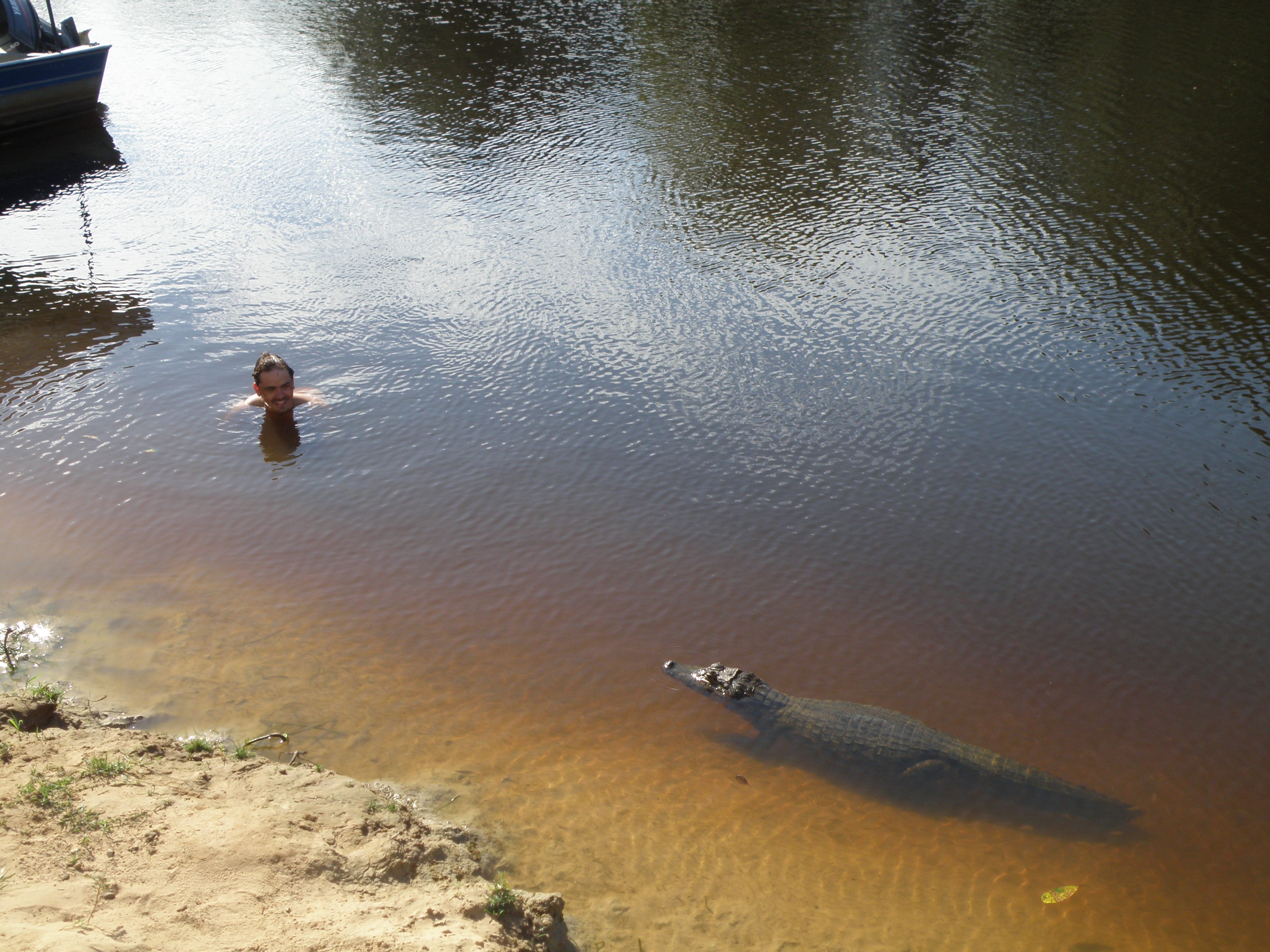
11 July, Santa Clara lodge, Pantanal
Early that morning, in addition to the now familiar cry of the Chacochachalakas, we were woken up by the ominous ruckus made by a troupe of Black Howler Monkeys. It was however a pleasure to lie in a hammock in the early morning ours listening to the sounds of nature, and even the less musical animal cries are a huge improvement over the sounds of construction workers and city traffic.
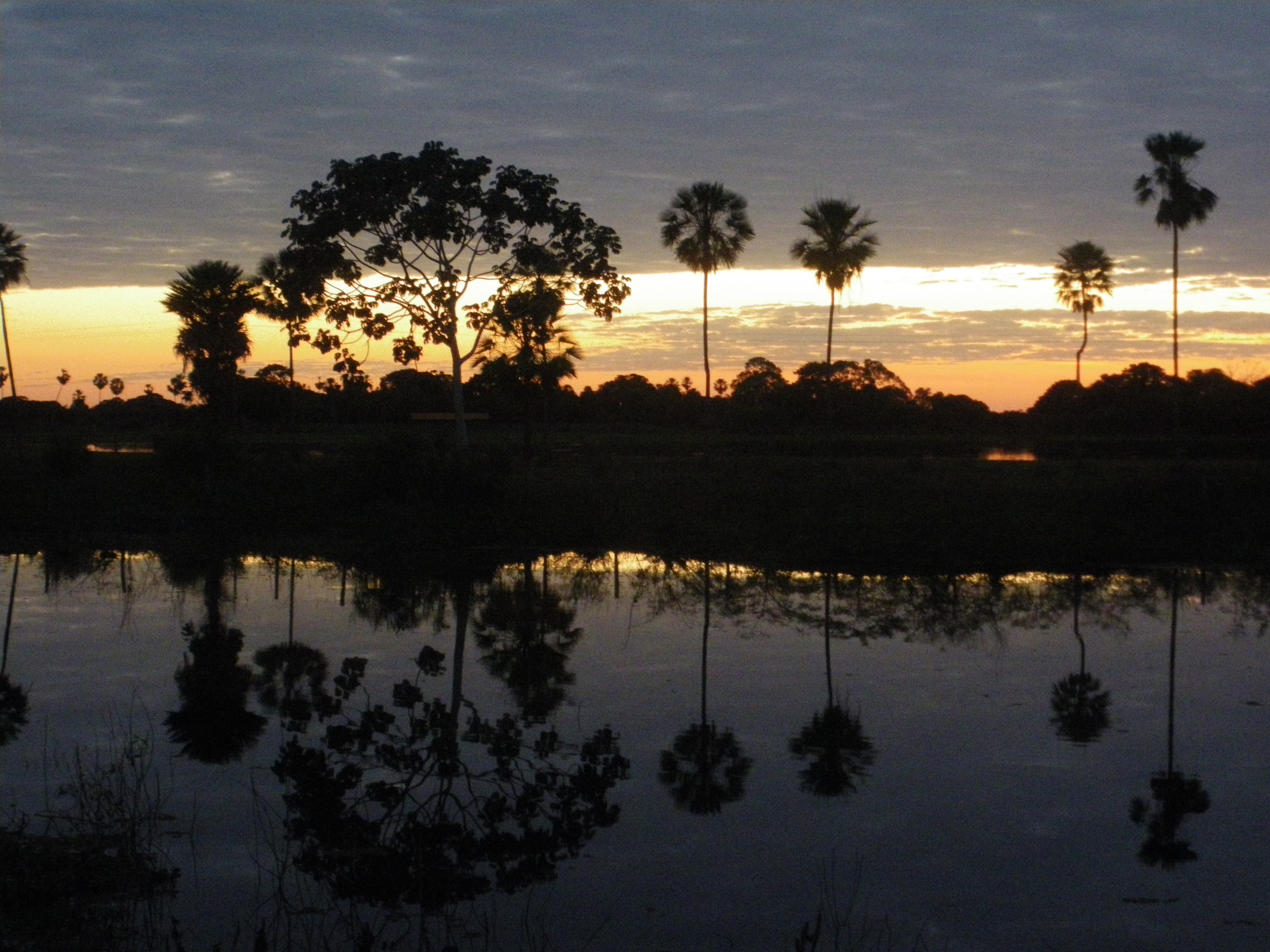
12 July, Santa Clara lodge, Pantanal
We spent the morning taking on a two and a half hour hike, during which our guide explained many of the medicinal properties of the local vegetation. Examples included the Yellow Trumpet Tree, whose bitter sap is a remedy for inflöamation. A water lily from which a hallucinogenic tea could be made, the Acori Palm, from whose seeds you could press drops of water to use as eyedrops. The Acori Palm was quite abundand in the area and seemed to be an important part of the local ecosystem. The leaves are fed on by the cattle during the raining season, when the grass is covered in water. The coconuts are eaten by armadillos to file their teeth and eaten by the Macaws, who can crack them open with their powerful beaks. From the hard shell covered fruit you can make a drinking cup, a plate or a horn with which to make a Jaguar call. Inside the hard shell of the fruit is a yellow flour (in addition to some worms) which is eaten by the natives. We were also introduced to Tuco, a bamboo used for making bows, and Caraguata, a bromeliad whose leaves are used for fiber. At this point I stopped taking notes and decided to concentrate on enjoying the hike instead.
Overall, the Pantanal was an enriching but not entirely stressfree and relaxing experience. Firstly, there was an unpleasant run-in with a very rude and unprofessional guide on the first day. Then, the huge amount of acquired mosquito bites coupled with steep temperature changes between searing hot in the afternoon and chillingly cold at night in addition to the everpresent and all-covering dust, meant that I was quite relieved to be leaving. On this trip so far, we have been happiest when we were doing our own thing on our own time. Taking part in a packaged tour of the Pantanal was just the opposite of that. The activities were fun and worth the effort and money, but there were just a few too many unpleasantries, none the least the way we were treated by some of the lodge staff, that make me remember the experience with mixed feelings.
13 July, Bonito
We arrived in Bonito (meaning beautiful) the night before, after a long and very bumpy ride on what was probably the most half-hearted attempt at creating a temporary gravel road in order to facilitate repairs on the main road. In other words, this gravel road was awful, and I had visions of our poor little minibus breaking down with us having to spend the night at the side of the road in the middle of nowhere.
Instead, all went well and we were now in the popular town of Bonito, renowned for it’s offering of beautiful caves and rivers and a whole range of activities associated with them. There was just one problem, the hostel where we stayed and all the activities it included, were terribly expensive.
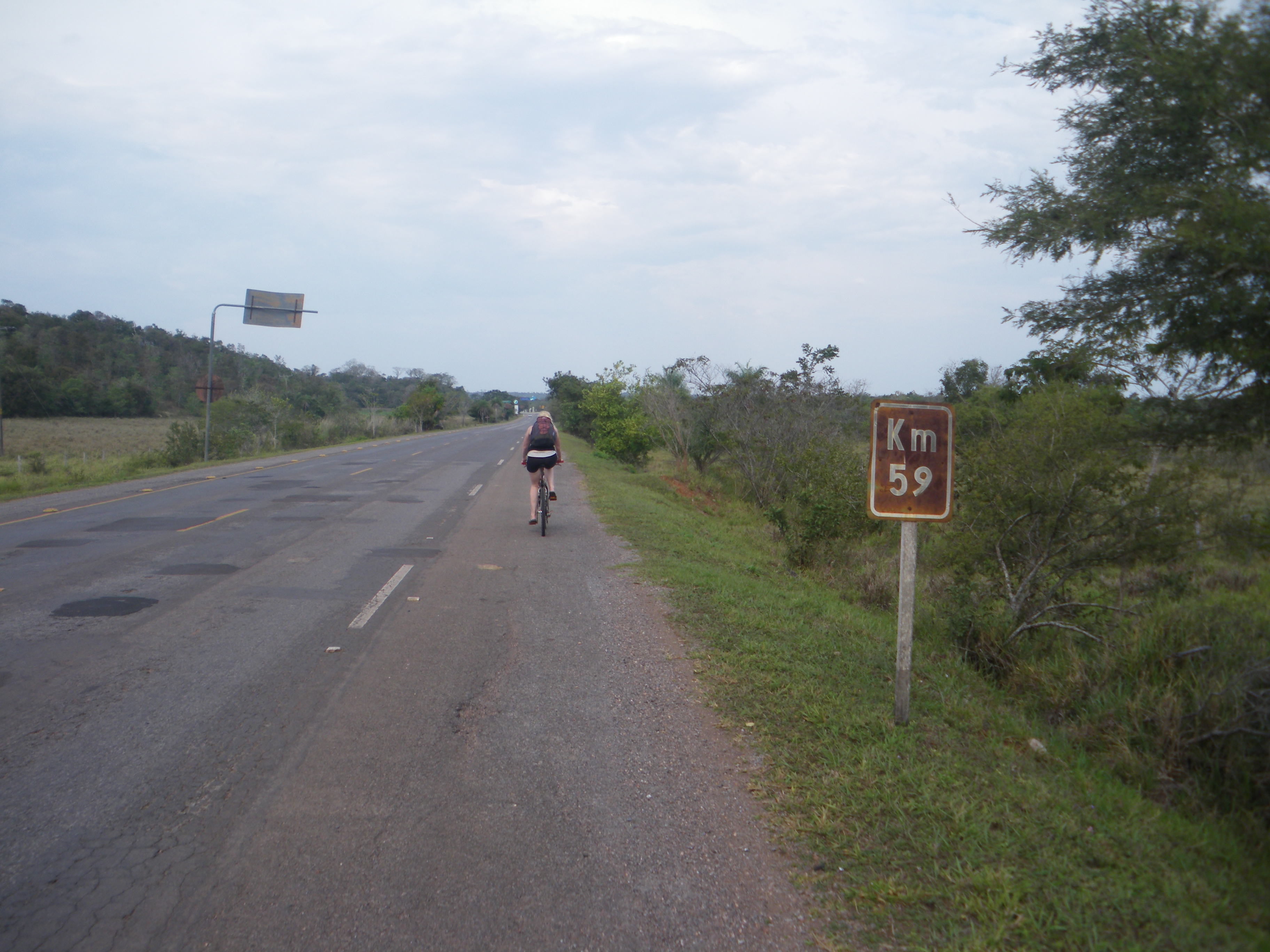
We therefore opted for the poor man’s alternative, rented bicycles and rode 7km to Banleário Municipal, where we could snorkel in the river. The bicycle trip out of town was a pleasure, providing another chance to take in and appreciate the landscape. Banleário Municipal was a pleasant surprise, next with a very beautiful and clear turqoise coloured river, swarming with fishes. We snorkeled for about two hours until it started raining, when we huddled under a shelter with two Brazillian caretakers discussing (in broken Portuegese) Brazillian weather/festivals/beer/people/etc. compared to their German equivalents. We were again struck by the friendliness of most of the Brazillians we encountered.
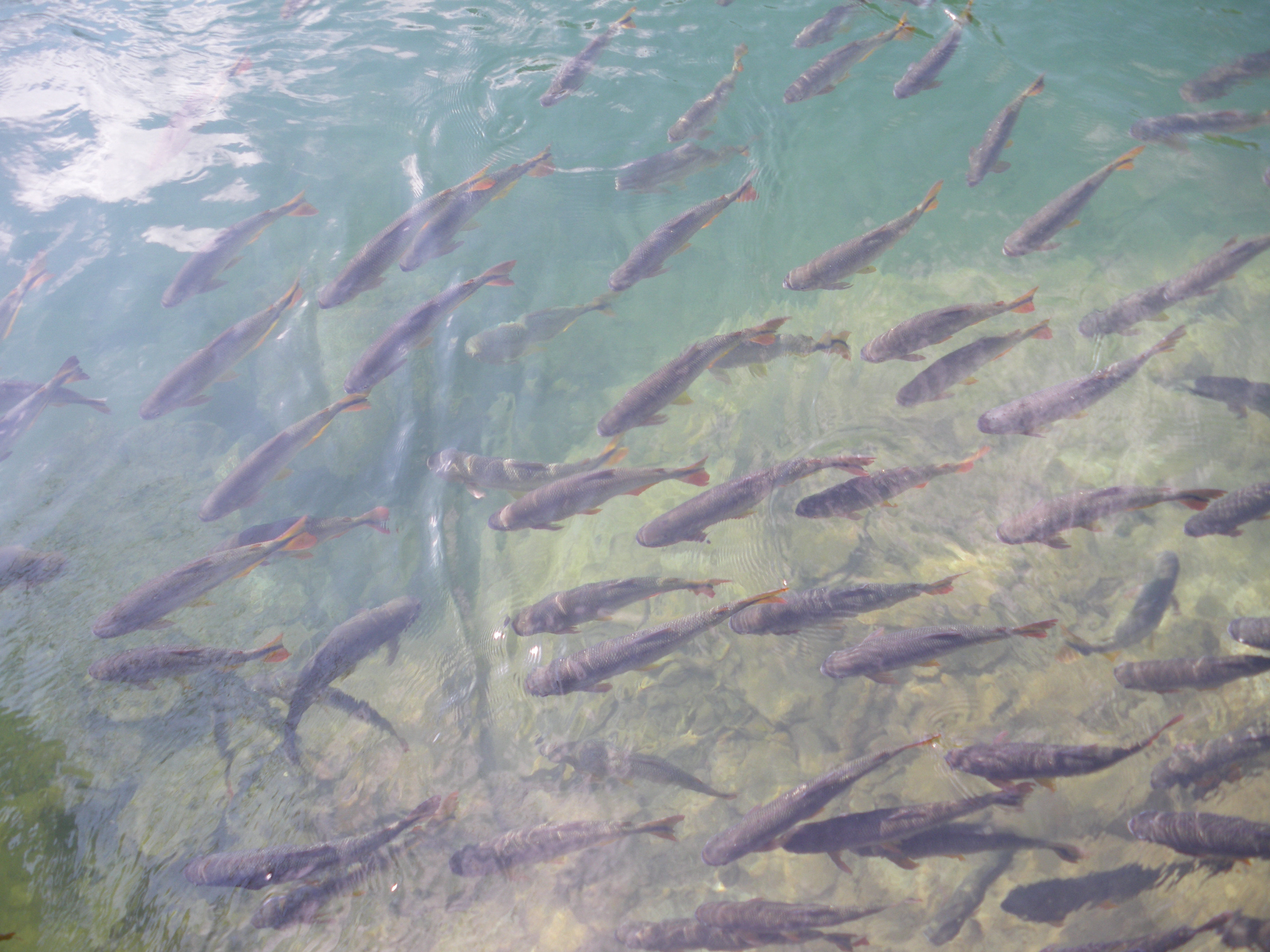
Bonito is definitely one of the richest most developed towns we’ve encountered so far, with quite a few very stylish and modern houses around town. Perhaps that’s why the activities were so expensive. It could also however just be an indicator of the wealth gap between the poorer North and richer South of Brazil.
14 July
After one day in Bonito, we left deviated from our original plan and decided to leave for Foz do Iguacu, a Brazilian border town near the Iguacu waterfalls. As we headed more and more south, the landscape and the climate continued to change, getting greener and colder. Some areas even reminded us of the south of Germany, with neatly kept green fields dotted with patches of forest vegetation (rainforest as compared to Germany’s temperate forest).
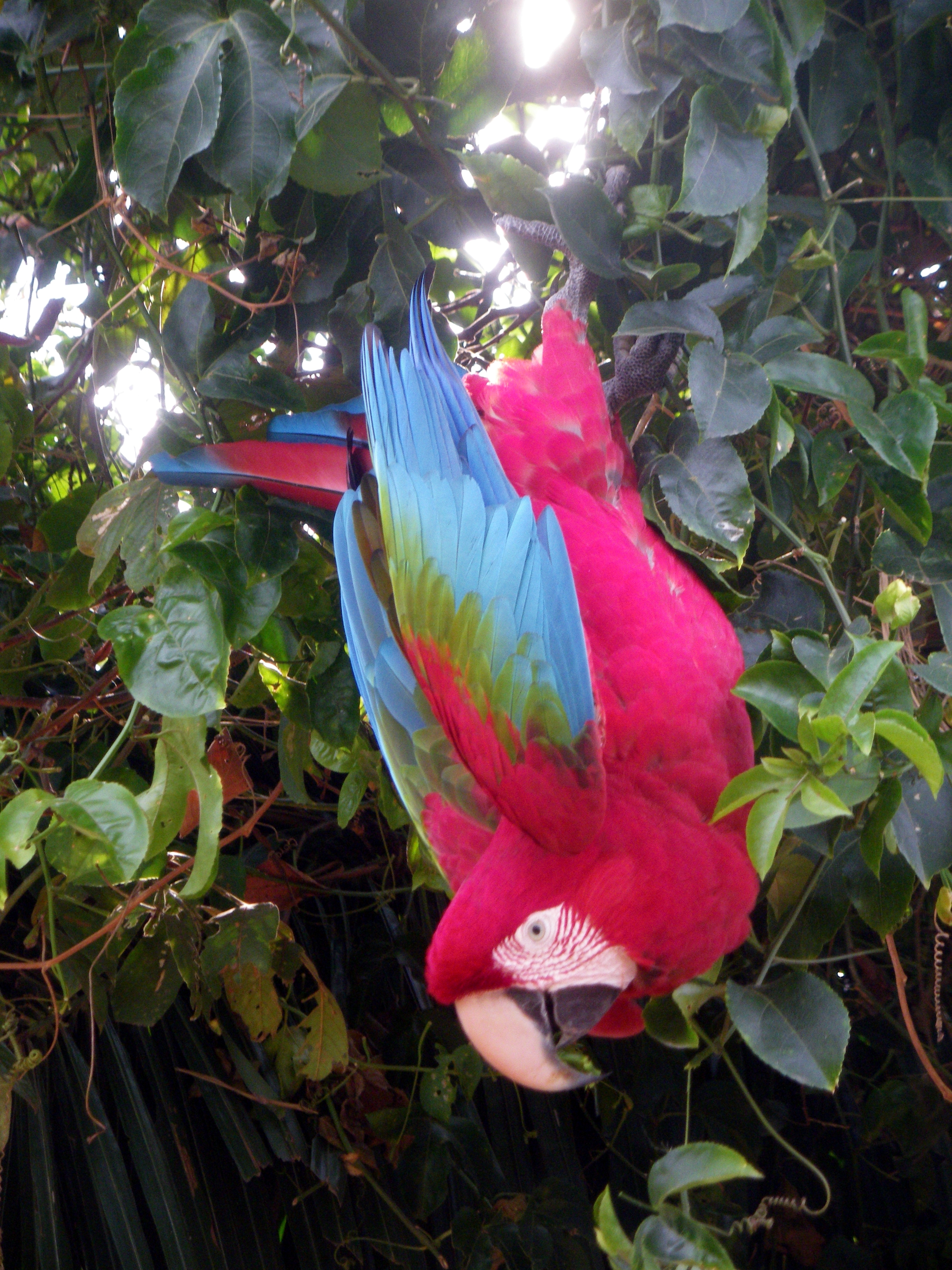
We had to change buses twice and waited about two hours in the middle of the night for one of the later ones, which meant that I was again very tired upon arrival.
We decided to take it slow, had lunch with a nice older Danish couple who (very patiently) were waiting with us the previous night for their own (even more delayed) bus. We swapped some travel stories and they told us about their adventures in Peru. Afterwards, we left for the Argentinian border town of Puerto Iguazu, to find some accommodation for the night.
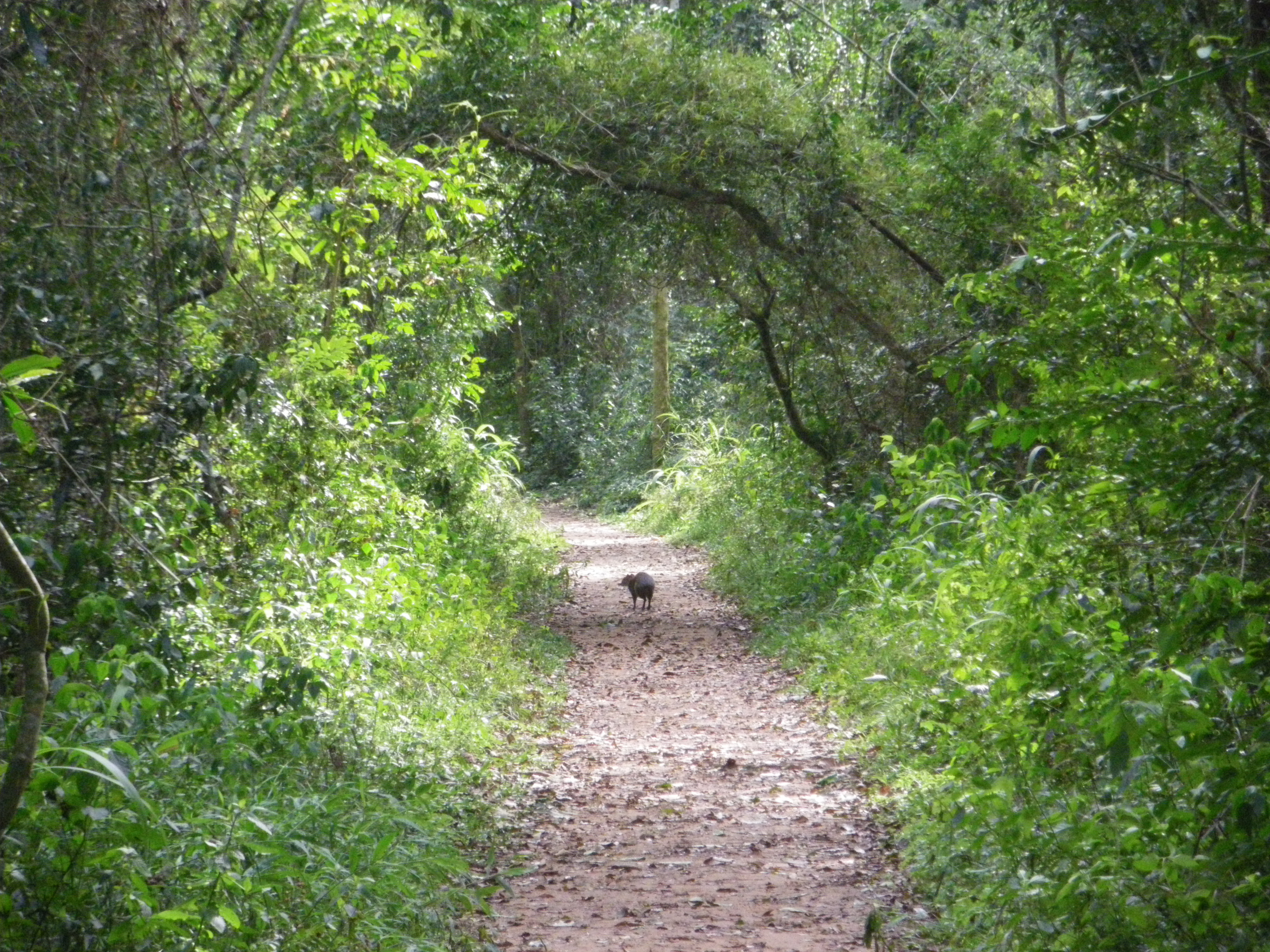
Upon arriving in Argentina, we quickly detected a different vibe, culture and look than we were getting used to in Brazil. The shops seemed to be better stocked and with more specialties.
15, 16 July, Iguacu Waterfalls
We spent two days visiting the Parque Nacional Iguazu, in which the spectacular Iguazu waterfalls can be found. The largest of which, is the Garganta el Diablo, or “Devil’s throat”.
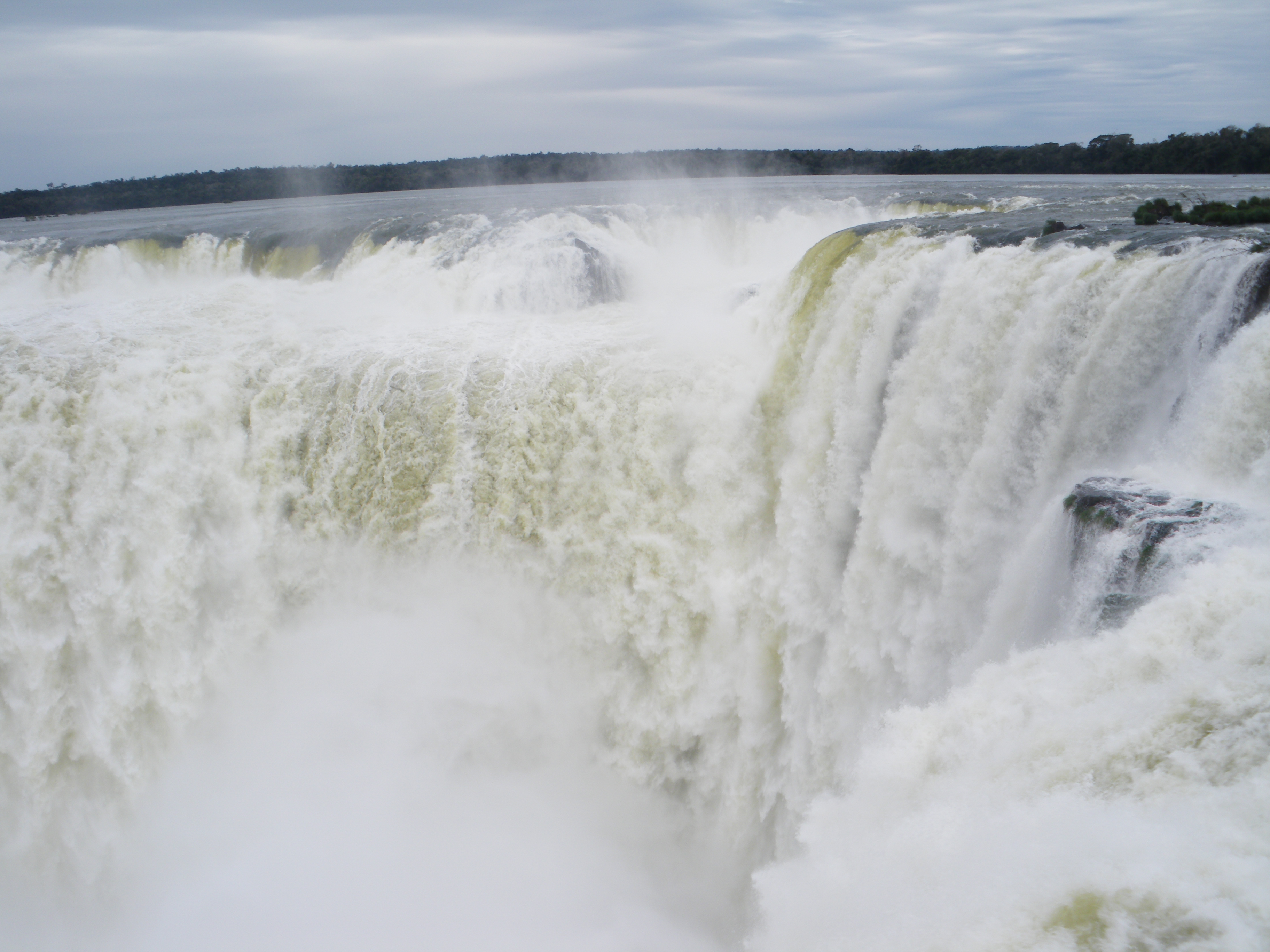
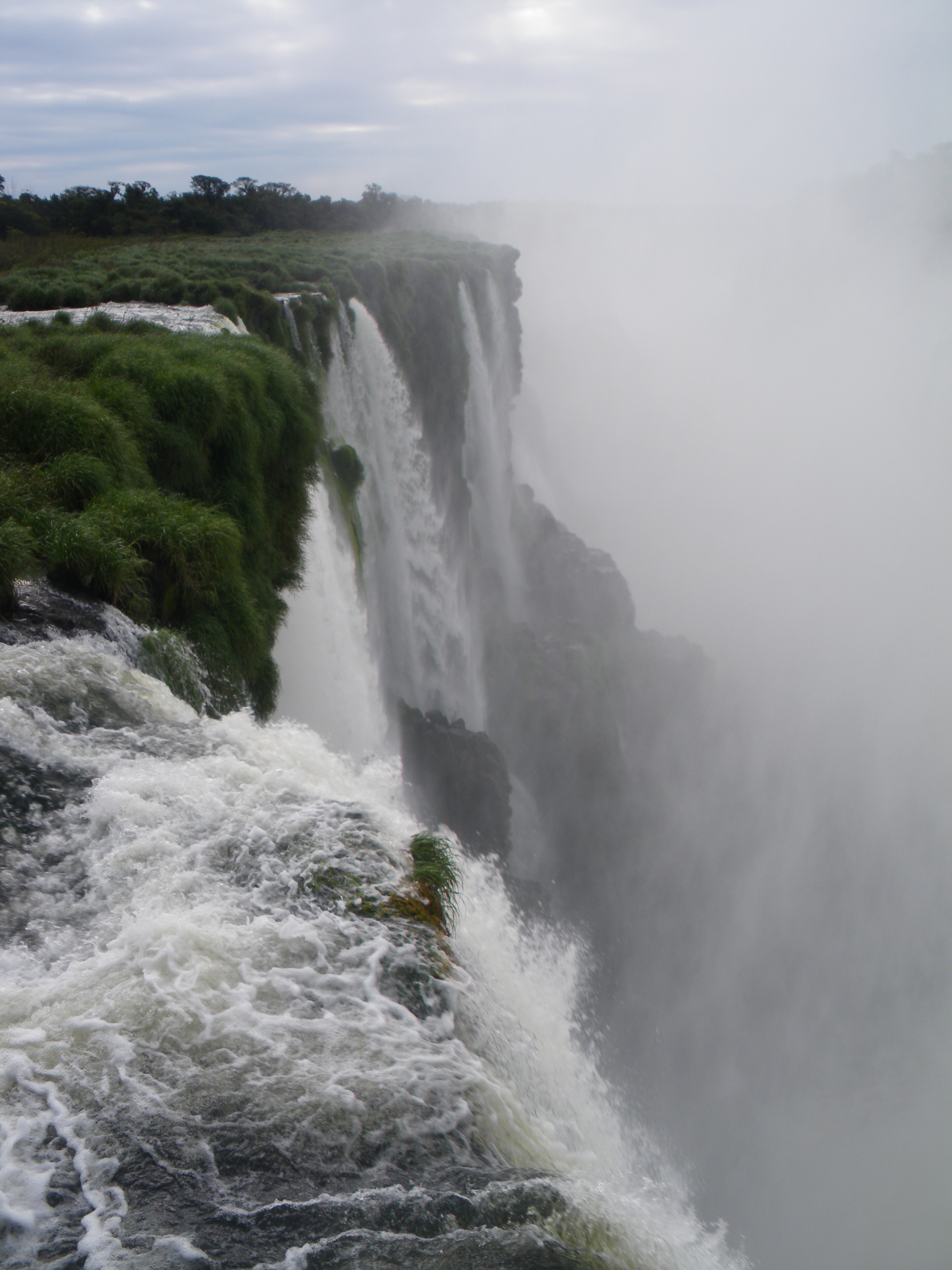
The magnificence of the this waterfall is beyond description. Enormous amounts of water continuously flowing over the edge and into a white abyss. The white mist making it difficult if not impossible to see the water below. When the eye looks on to the water pouring over the edge, it tries in vain to find something in the ever changing sceneto focus on, giving rise to a mesmerizing effect. I felt as if I could have stared at the falling water for hours.
There are 269 other waterfalls, extending to both sides of this monster, creating a wide vista so impressive and beautiful that no picture or photo could ever do it any justice. We know, not just because we tried to capture it with our small 100€ camera, but also because we could not find any postcard, poster or picture elsewhere that captured their splendour. Simply put, they are much too big to adequately fit in any picture while still maintaining a perspective of their true size.
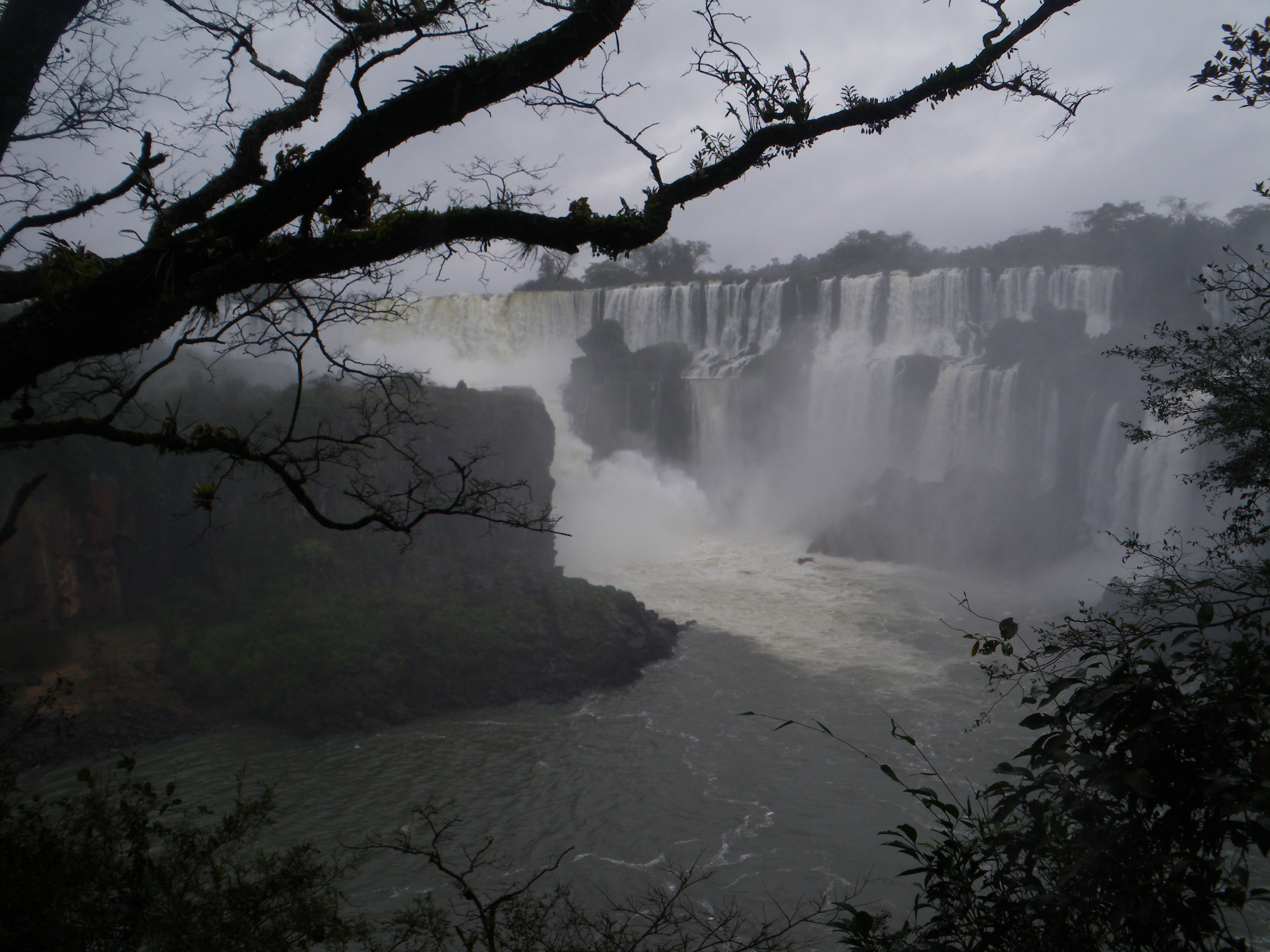
On the second day, it was very cold and raining, which dampened our enthusiasm a bit, but after seeing a blind person visiting the park the previous day, things were placed in perspective and I was grateful for having the good health and fortune to see these impressive waterfals.
18 July, Tres fronteiras park
After our rainy excursion to the waterfalls, I fell ill for about two days in which we stayed inside at the hostel. The small ten person dormitory was particularly suffocating for Manuela who didn’t like the hostel to begin with.
On the second (and our last) day, I however started to feel better and we decided to walk to the “Tres Fronteiras” park, were you could see Brazil, Paraguay and Argentina all in one view. The park itself was free and our spirits were lifted after getting out of the hostel for a change.
19 July, Ciudad del Este
Ciudad del Este is a chaotic Paraguayan frontier town on the border with Brazil and Argentina and the second biggest city in Paraguay. Its entire economy seemingly depends on its large markets of (mostly cheap Asian) consumer goods which are bought by Brazillians looking to save money by avoiding customs and sneaking the goods back through the border. Often the goods are then resold on the Brasillian side.
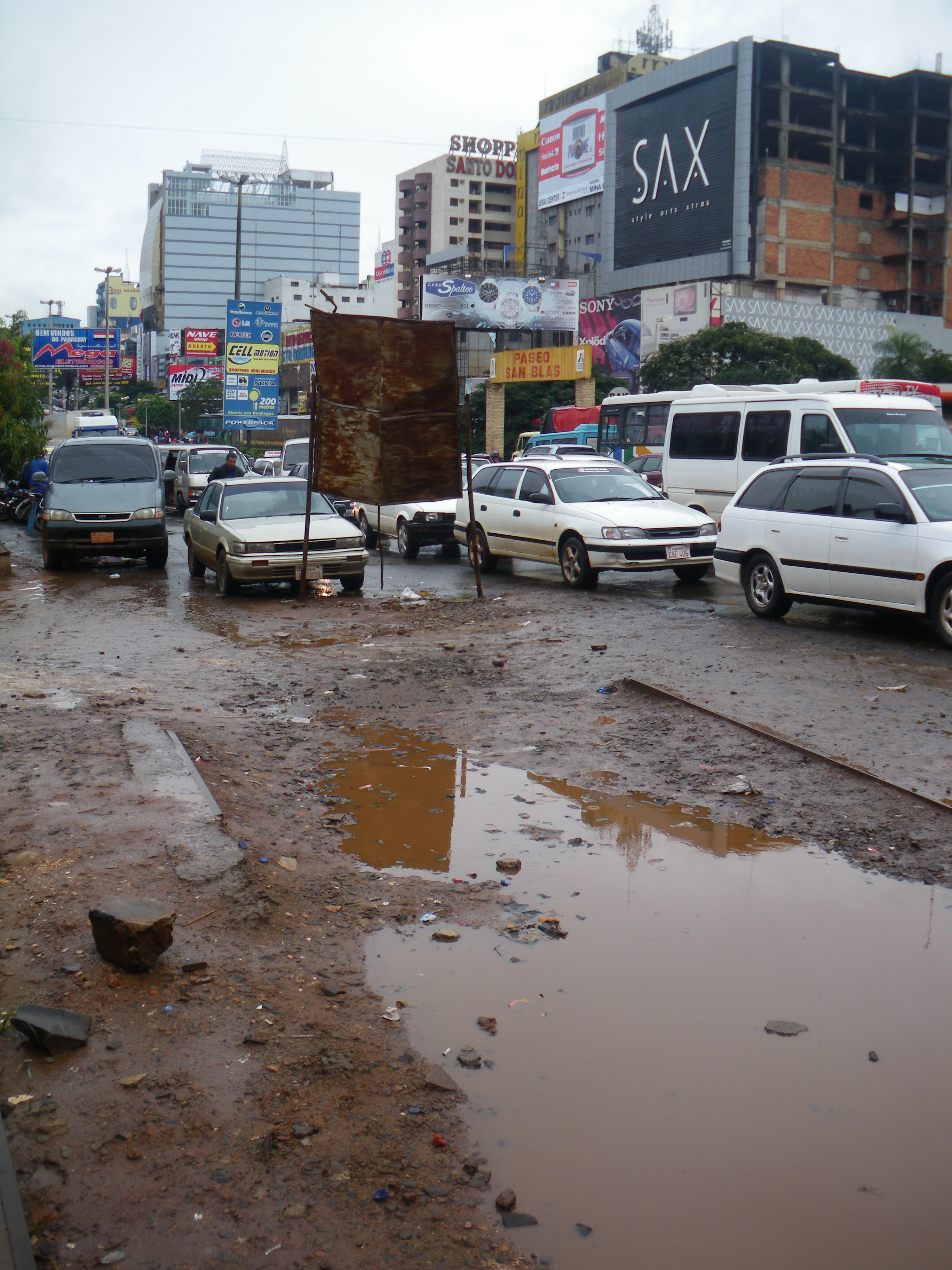
Many people who visit Ciudad del Este for a day don’t even bother to get their passports stamped and the buses and taxis who cross the border from Brazil wont stop at the passport controls unless you specifically ask them. Upon nearing the border, we however decided not to tempt fate, and asked our bus driver to let us out to get our passports stamped.
Upon entering the city via the “Friendship bridge”, we immediately saw the large markets covering all available sidewalk space. Many of the buildings between the sidewalks are also filled to the brim with small markets and shops. We didn’t experience the Paraguayans as being too aggressive salespeople however and usually didn’t feel badgered to buy crap we didn’t want.
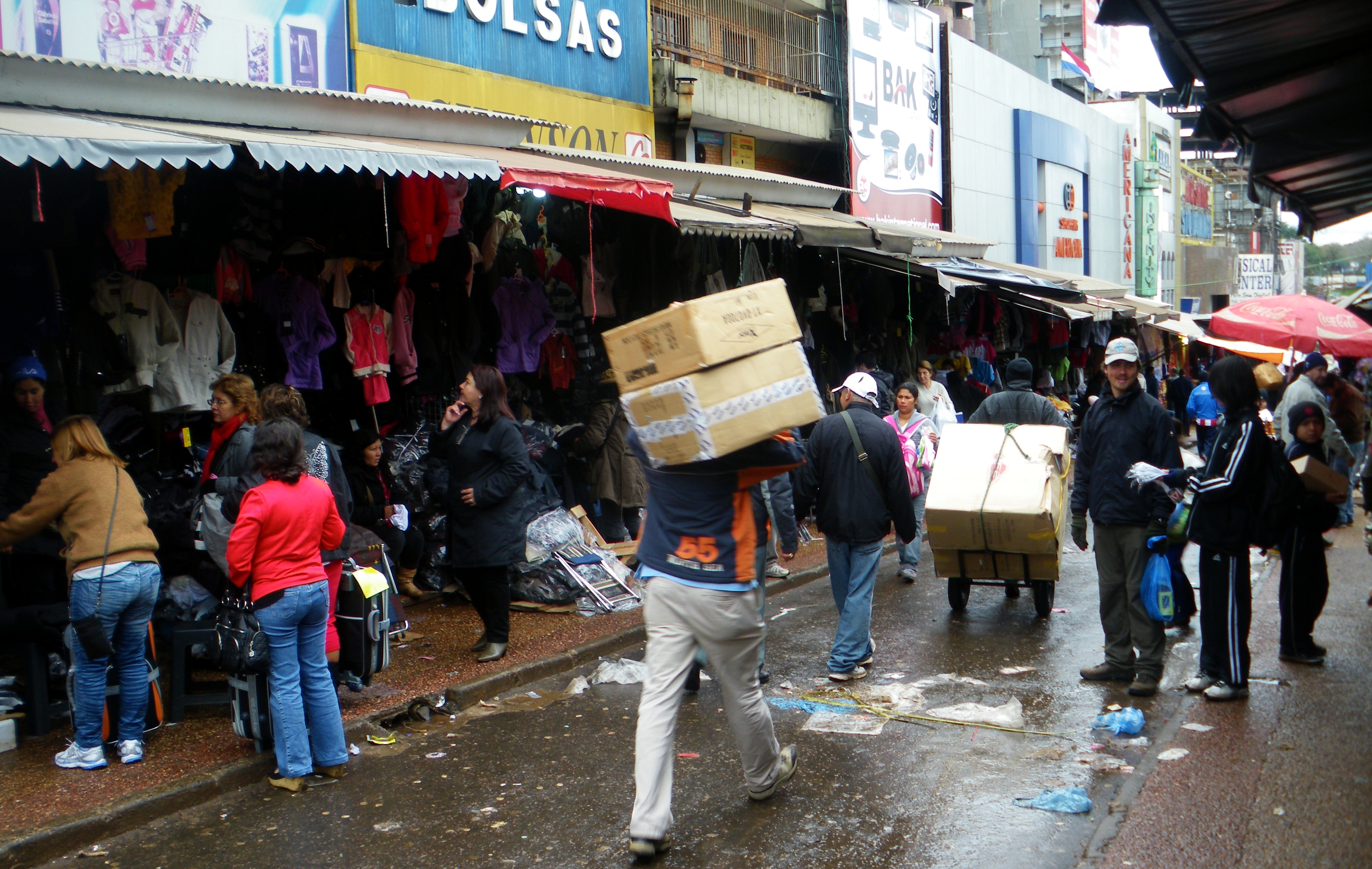
It was raining during our excursion, and this only highlighted the neglect and disrepair of the city itself. Large potholes were filled with brown water, and some buildings seem to never have been painted. By chance, we passed a mall (more like a narrow 5 story department store than a mall) called “Mona Lisa” which we recognised from large billboards in Brazil, urging shoppers to go to Ciudad del Este and shop there. We decided to take a look.
Inside we were quite surprised. Fancy and expensive cologne and fragrants, new Ipads and Iphones, imported Swiss chocolate, Sushi and a whole assortment of other luxury items. The mall itself could be located in any big city in the world, but the contrast with the disheveled, dirty and poor spectacle going on outside its walls was striking.
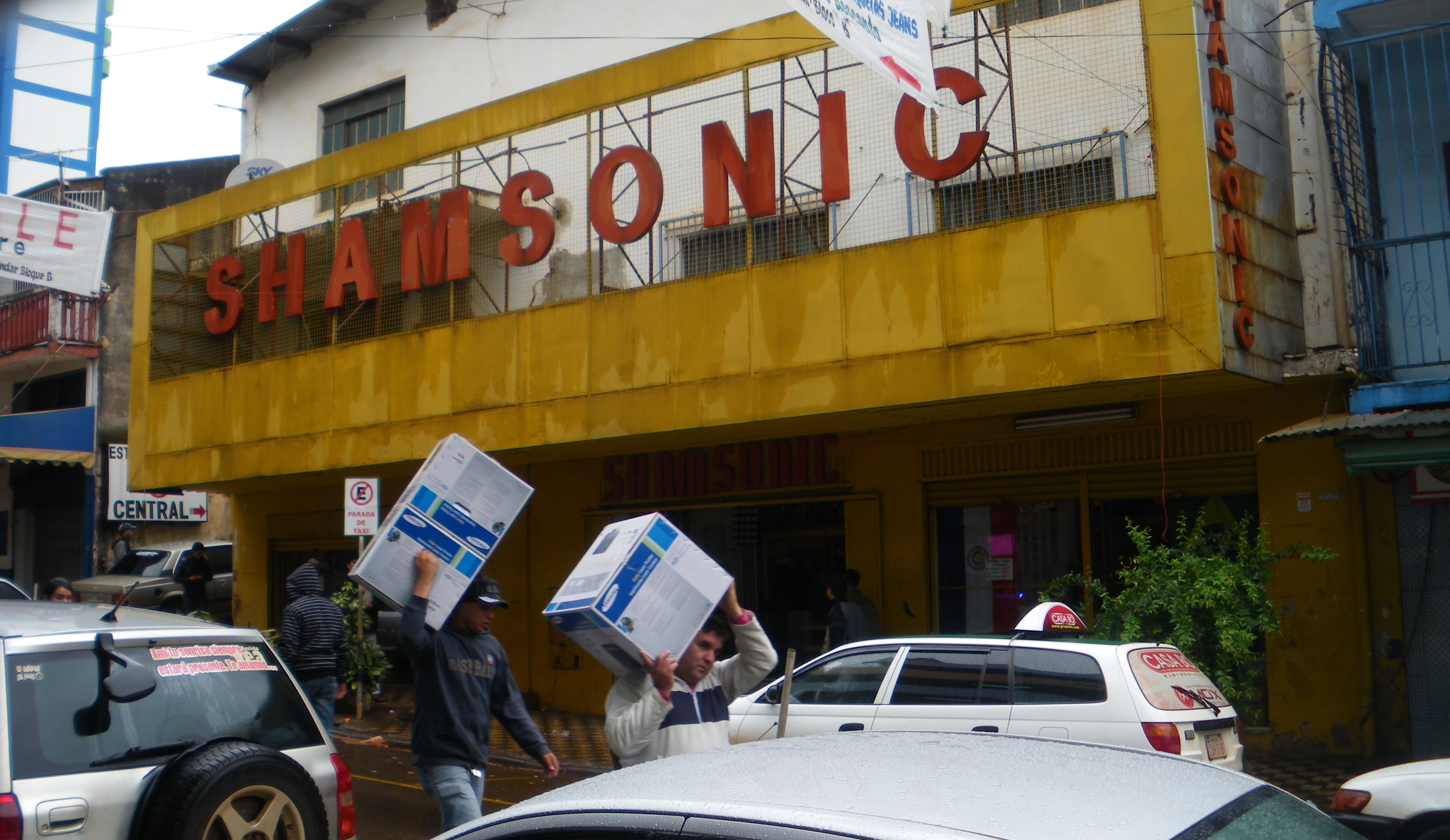
At the end of the day we took a minibus taxi back across the bridge to Brazil. The one guy sitting next to Manuela looked quite nervous as we neared the Brazillian border but as the taxi driver made a point of speeding around the border gates he relaxed visibly and made a Catholic cross with his right hand. Everyone
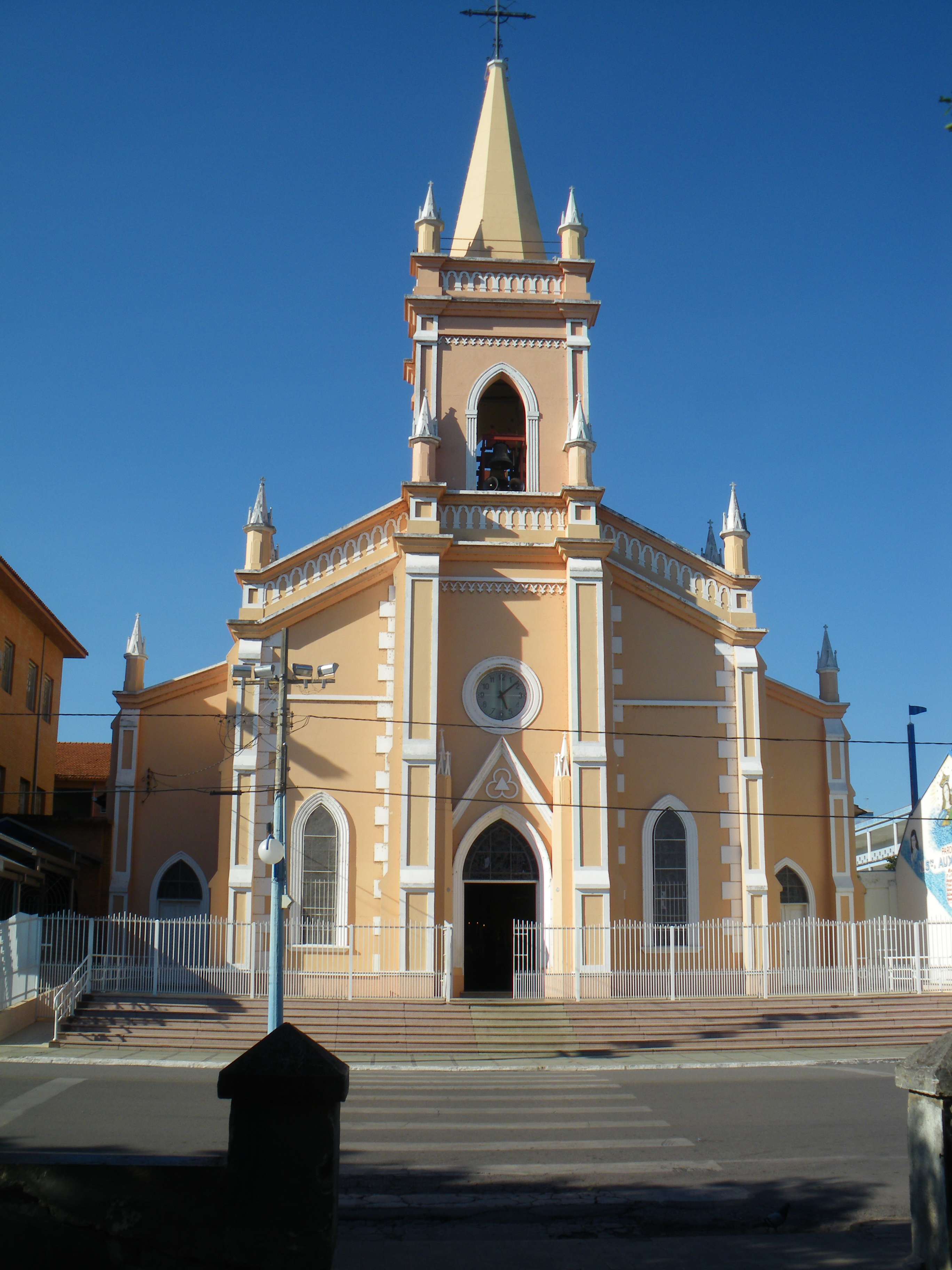
was therefore a bit surprised when the two gringos in the back asked to be let out to go and stamp their passports again. The driver pulled over
right there at the side of the road, ignoring the hooting from the irritated drivers behind us and let us out, before speeding away again.
On the same day we took a long distance bus back up to Corumba on the border with Bolivia.
21 July, Puerto Quijarro
We spent a day in Puerto Quijarro, a small dusty Bolivian frontier town on the border with Brazil. After having spent almost all my cash in obtaining a visa I wasn’t aware I needed, I had to find a place to withdraw some more Bolivianos. Neither of the two cash machines in the town accepted my card however. Again the problem seemed to be that I had a Mastercard. In fact, I had two, which feels like having two left feet at a dancing contest. In South America, Visa is accepted almost everywhere, Mastercard however is a different story. In the end we had to take a taxi to the nearby town of Puerto Suarez, to use their ATM, which did accept my card.

As a result of this, we didn’t have a chance to buy train tickets to Santa Cruz for the day (you can only buy tickets in person and for the same day), and ended up being the only two guests staying in one of the nicest, most spacious hostels we’ve ever been to, Tamengo. It used to be the local public swimming pool, before the current owner bought it and turned it into a hostel. The town of Quijarro was so poor that it seemed unlikely that the municipal would have had the funds left to maintain a public swimming pool.
22 July, Train from Puerto Quijarro to Santa Cruz
We woke up early and made sure to get tickets for the train later in the day. We would be traveling on what is known as the “death train”, apparently because it was used to transport yellow fever victims in the past.
The train shaked and dipped along at a snails pace. On a small television at the front of the compartment, Spanish songs from the 1970s were playing, sung, among others, by an overly zealous woman with kitsch, bright make-up and a priest with a guitar. Early in the day I heard an old 90s techno song blaring from some car’s speaker in a dusty road populated with chickens, pigs and countless stray dogs. So far, being in Bolivia has presented its strange moments.
23 July, Traveling from Santa Cruz to Samaipata
We arrived in Santa Cruz, after a harrowing 17 hour train ride. The compartment bumped, stuttered and shaked, and occasionally there would be very loud bangs coming from below as we not only swayed in a sideways motion, but also vertically, with the bottom of our carriage banging on the tracks below. On occasion the train swayed so much that I would instinctively prepare for the inevitable tipping over of our carriage. In the end, the inevitable seemed to be avoided, or perhaps just delayed for a later time.
One of the first things noticable about Santa Cruz, as we zipped away from the bus station in a taxi, was that there were no high rise buildings, and everywhere seemed desperately poor, although we went past a car dealership selling luxury 4x4s, including a Porsche Cayenne. Nevertheless, Bolivia is one of the poorest places I have ever visited, outside of some pockets in Southern Africa. Coming into Santa Cruz with the train, we saw an unplanned sprawl of shoddy structures, bisected with dirt roads. Rubbish is strewn everywhere, and in between chickens, pigs, cattle and people roam listlessly looking for something to do or eat. The children seem happy though, having fun playing in the dirt. Bolivias population is mostly indigenous, and for some reason their babies are incredibly cute, with dark elf-like eyes.
We spent about 3 hours in Santa Cruz and then took a minibus taxi to Samaipata (30 Bolivianos each), but after 20 minutes of alternating acceleration, then braking, then snaking through traffic, our driver sped over a speedbump and the car broke down. We had to all get out at the side of the road and wait for a replacement minibus to arrive.
The new driver was older with big, very thick glasses. I wasn’t sure whether this should instill confidence or fear in his ability to see objects in the road. Every now and then he would unceremoniously stop the car and jump out to take a piss at the side of the road in full view of the occupants. Later we were all almost killed when he narrowly avoided being driven over by a large oncoming truck. All the time without any communication from his side or the slightest apology. When we arrived in Samaipata, he simply drove past and we had to tell him to stop and insist that he turn back and drop us off. Now suddenly he was very chatty with the other occupants, no doubt complaining about the gringos in the back.
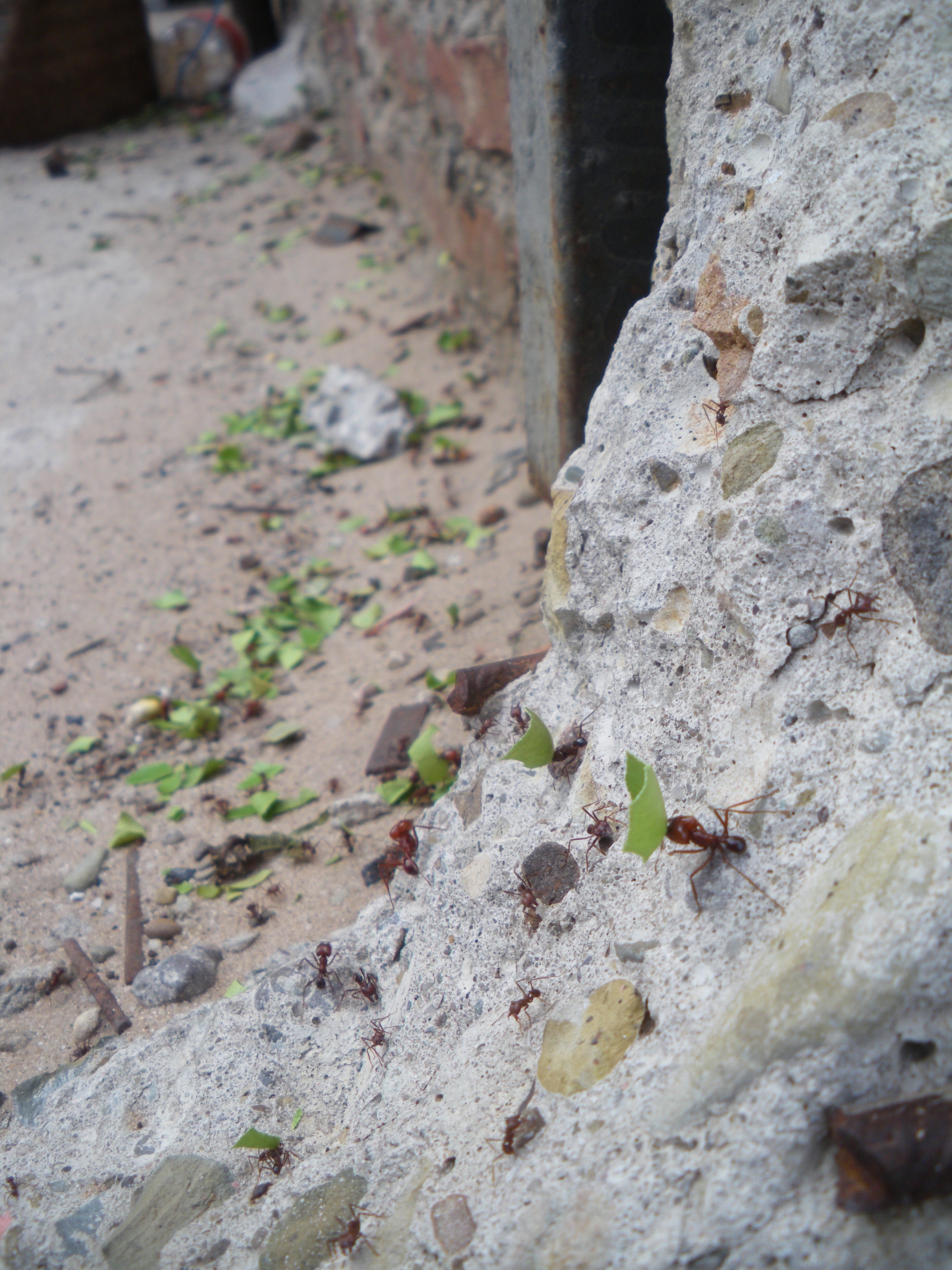
As he sped away, we were however more relieved than anything else, and looking forward to a new week of adventures.
A cliché in many people’s minds is that indigenous populations live closer to the land, more in harmony with nature and have more respect for the earth than the greedy, exploitative westerners. Sadly, this is not the picture we were presented with in Santa Cruz and on the way to Samaipata. Many people seem to lack any sense of responsibility for caring for their environment, painfully evident by the fact that the whole countryside seems to be covered in rubbish. Plastic bottles, wrappers and the like are simply thrown on the ground, with no regards for the terrible visual and environmental pollution it causes.
24 July, Samaipata
Samaipata, a town of 3000 inhabitants in an “ellbow of the Andes” with no bank branch, ATM, supermarket or dedicated internet connection, is the provincial capital of the province Florida and even boasts a court with 2 apparently unbribable judges. Unless you pay them in cash.
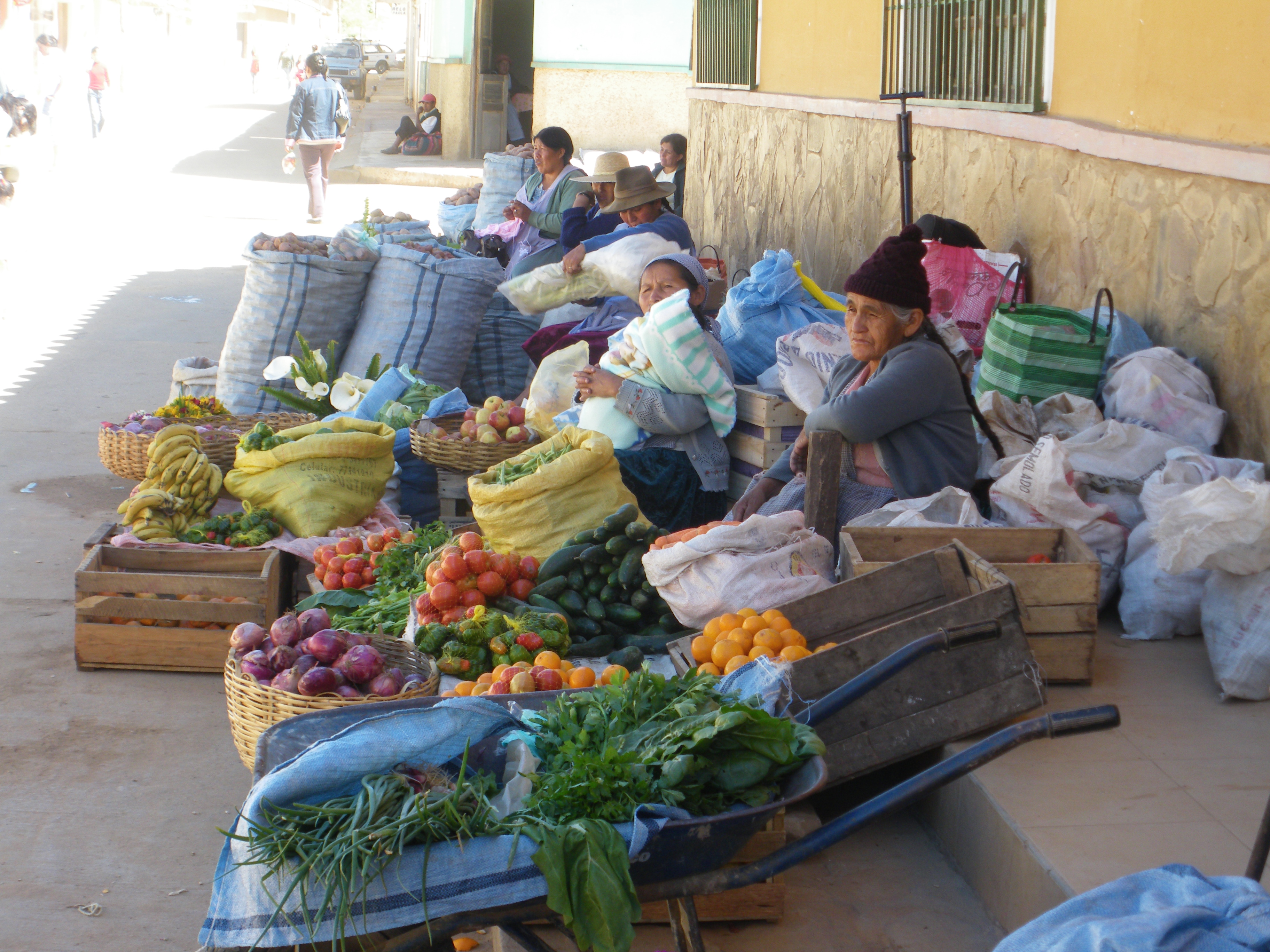
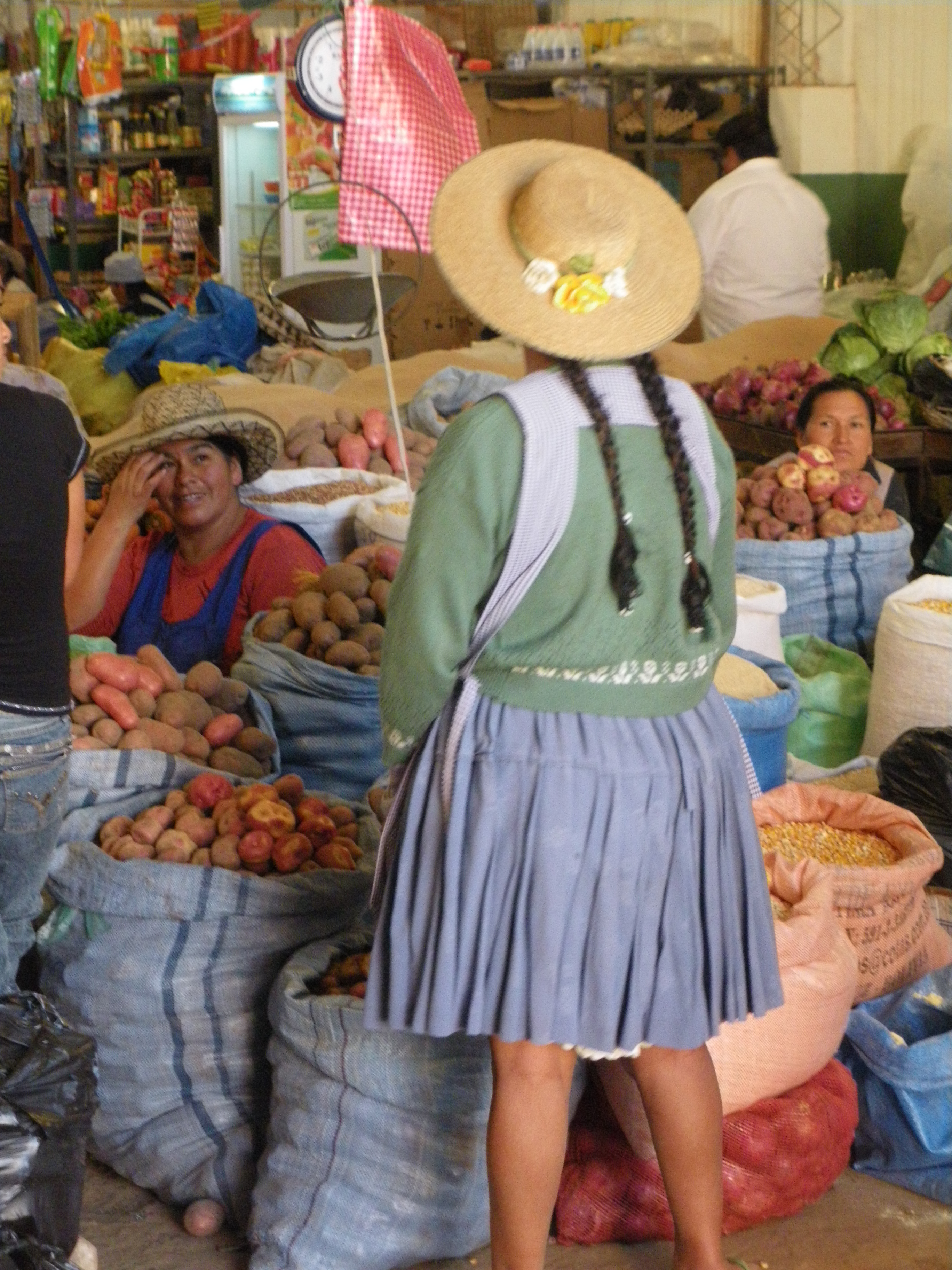
There is however a wonderful fresh food and meat market that more than makes up for the lack of a supermarket. The apples and pears in particular were delicious. There’s also a small European expat community (particularly Germans and Austrians) who provide tours, good restaurants, cafés and even a very good French bakery. Not to be outdone, there was also a very good local restaurant that we would often frequent during our stay.
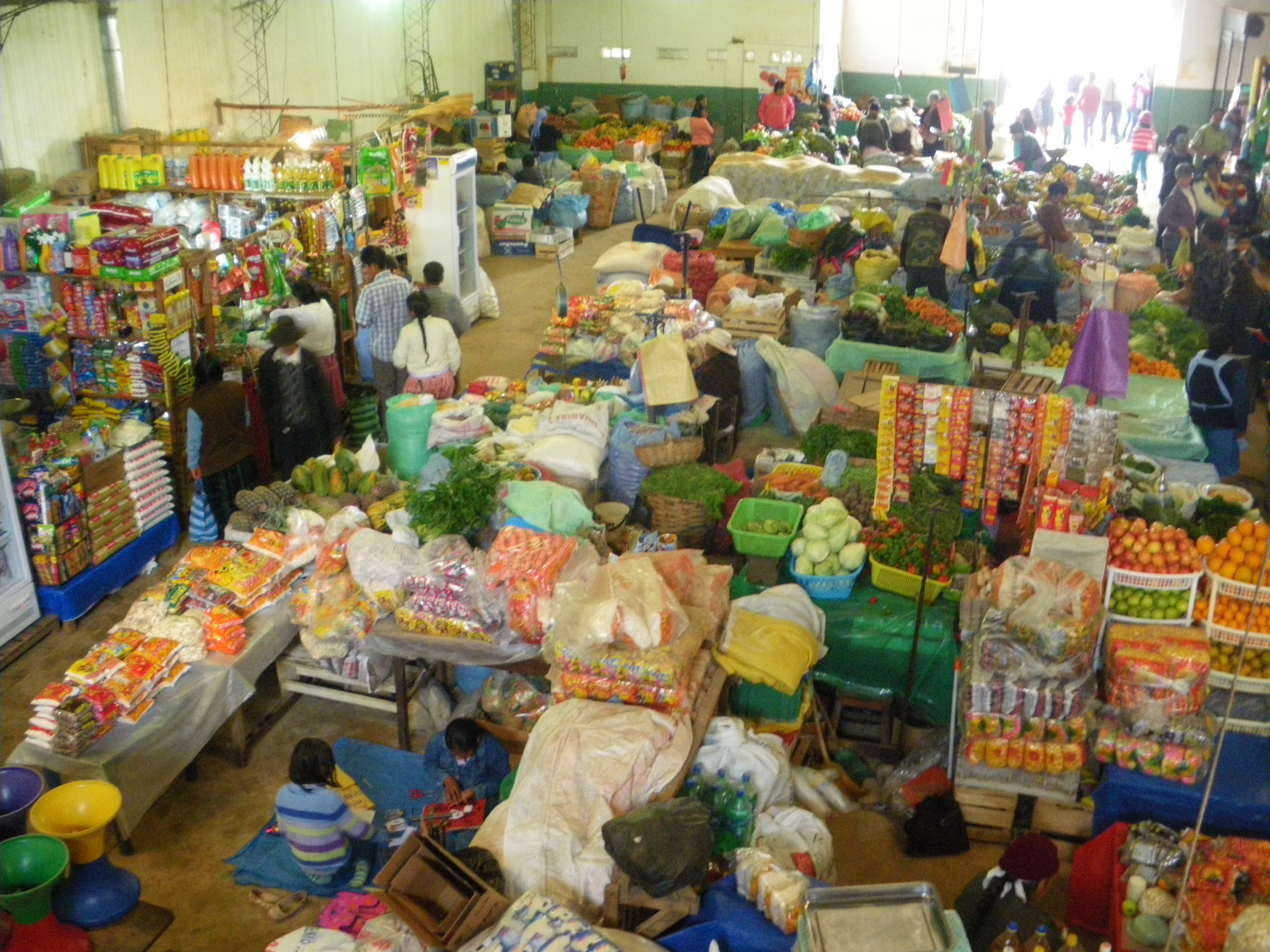
Samaipata is located in a valley, with the rainforests of Amboro National park on the one side and a much dryer semi-arid climate on the other, which of course makes for a lot of diversity and interesting scenery.
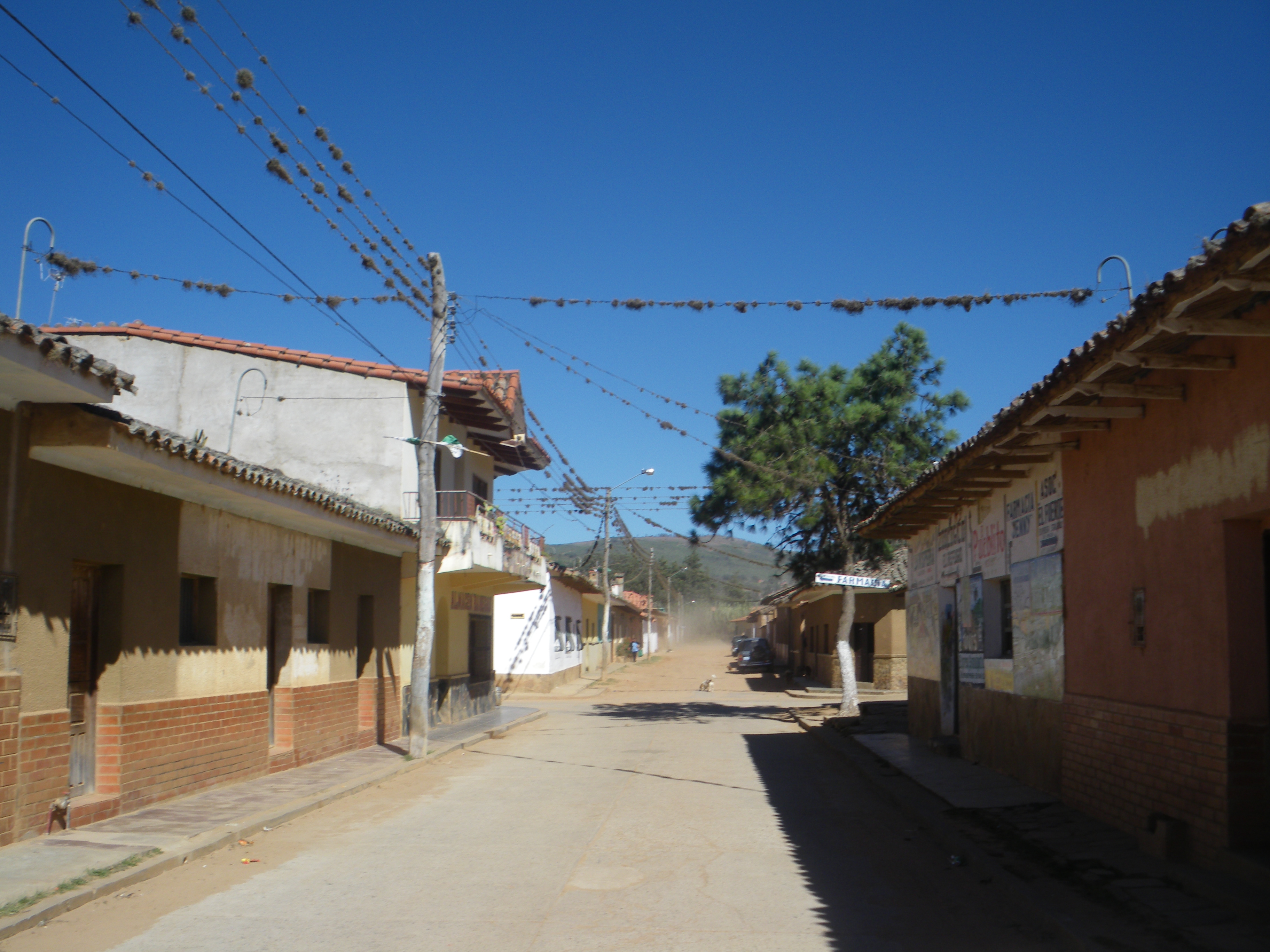
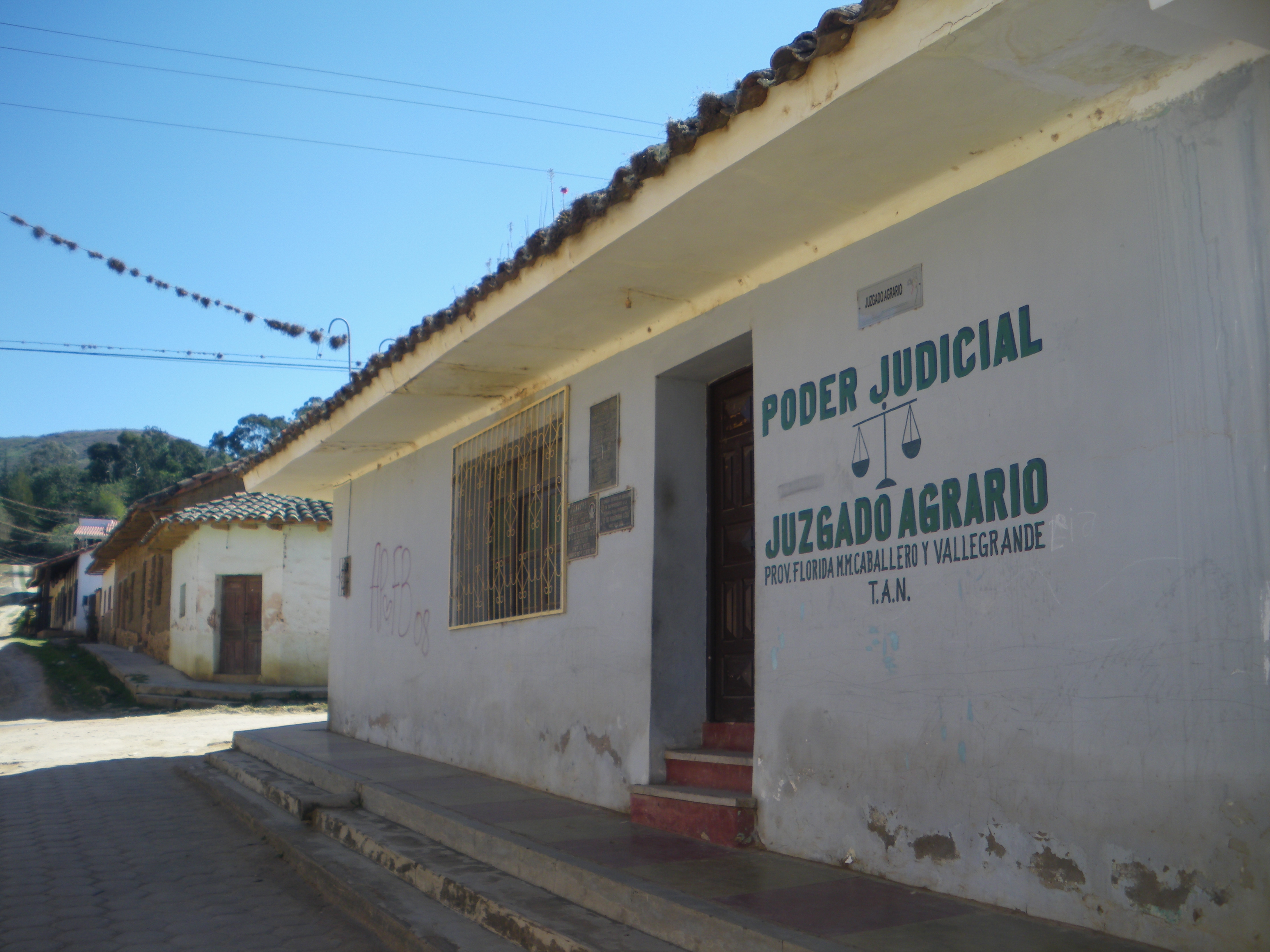
On that morning, we met up with Tony and Sofia, whom we first met in Rio de Janeiro and stayed in contact with since then, and together decided to take a hike to a lookout point on one of the hills nearby. Long story short, we took a wrong turn and instead ended up at the local “Zoo”. More an animal refuge run by an expat Swiss wonman, with a selection of touchy howler monkeys, spider monkeys, a three legged wild cat, some dogs, wild pigs, tortoises, macaws, parrots and a selection of other critters. Our visit more than made up for not finding our lookout point and we were glad to contribute in a small way towards protecting the abandoned and traumatised animals.
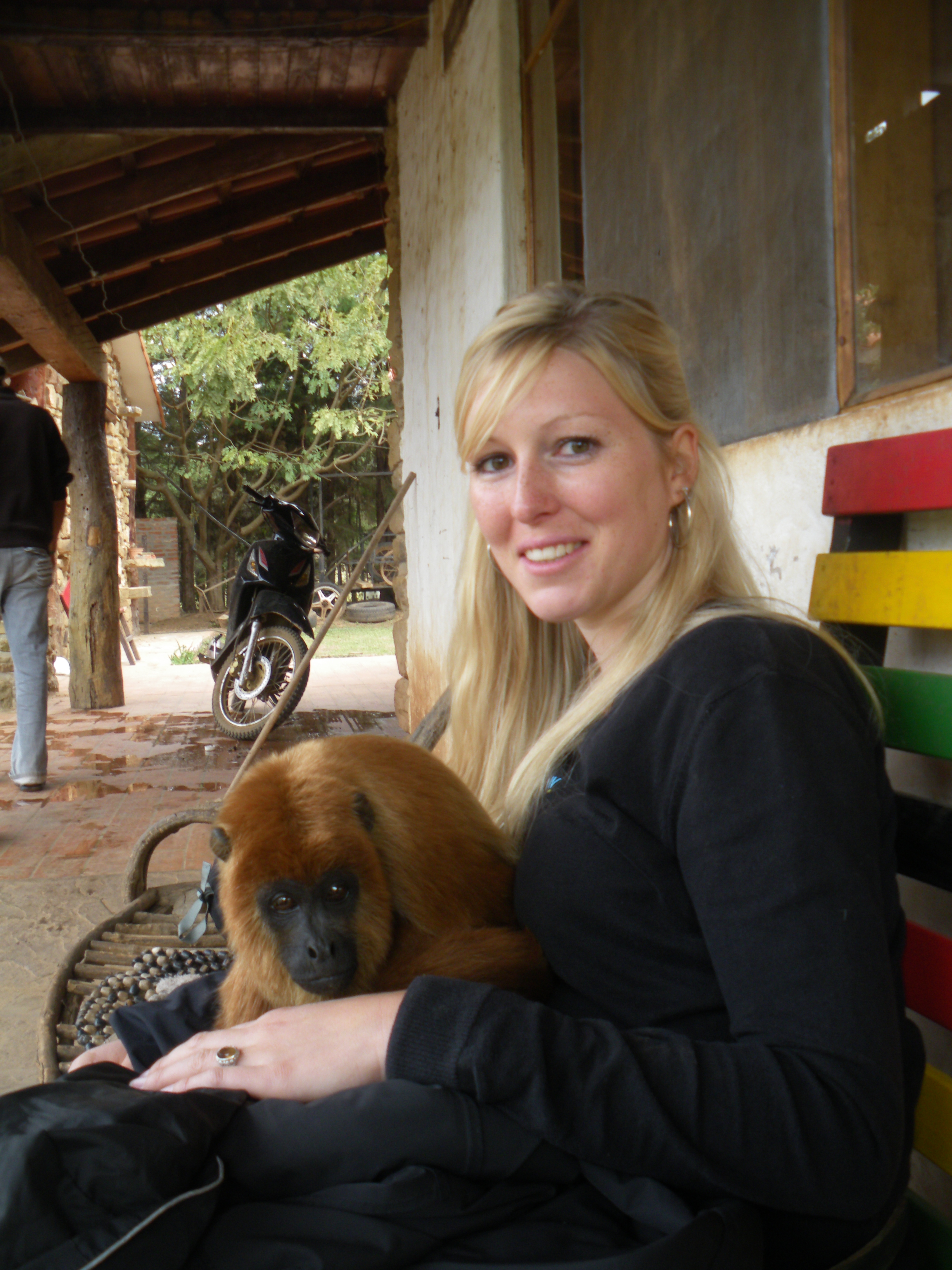
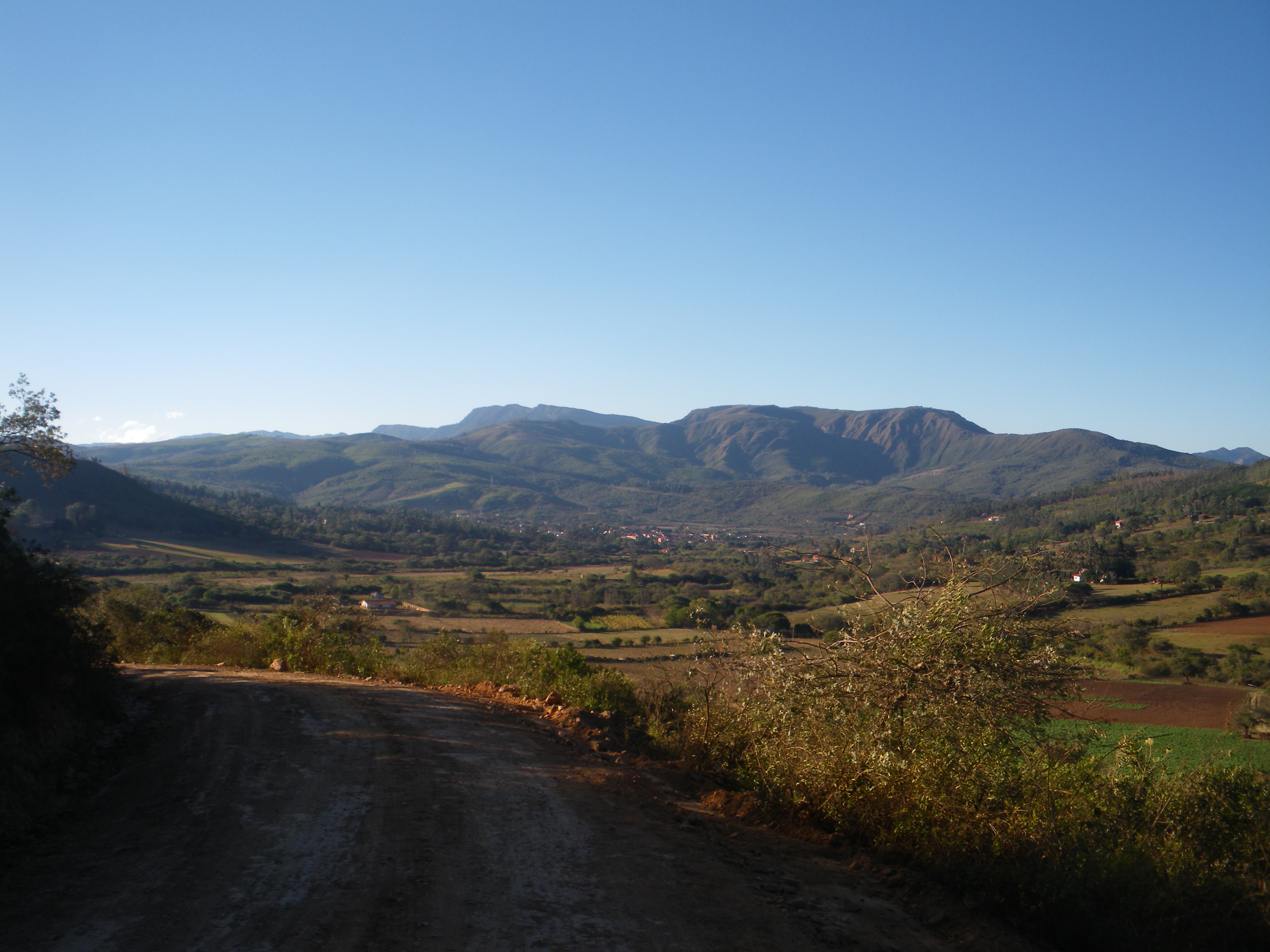
26 July, Horse-riding
We returned to the zoo to rent some horses and rode up a nearby hill with a lookout point called “Mirador El Paradiso”. One of the dogs of the zoo went with us and he was later joined by another dog from a nearby farm. They accompanied us all the way up to the top of the hill, with the one dog making sure that any and all wildlife were thoroughly chased away before our arrival, by running out ahead and barking loudly.
The lookout point provided a very nice vista of the surrounding hills and valleys and the horses could even graze a bit at the top. The whole trip took two and a half hours at about €13. Money well spent.
27 July, Bella Vista
One of the oldest tour agencies in town (they might actually be the oldest) is called RoadRunners, started by a loud but very friendly Austrian named Olaf about 15 years ago. I was initially attracted to their shop when I saw that they had a book exchange with a broad selection, and in the end Olaf was nice enough to lend me a thick biography on Che Guevara. Che’s last guerilla mission was in Bolivia, and before he was eventually captured and killed somewhere in the area, his men went down to Samaipata to rob a bank and retrieve some asthma medication for Che. One local guard was killed and in the excitement the guerillas fled from the scene and the shocked villagers without remembering to get any medication. Che was condemned to suffer from acute asthma for the rest of the campaign.
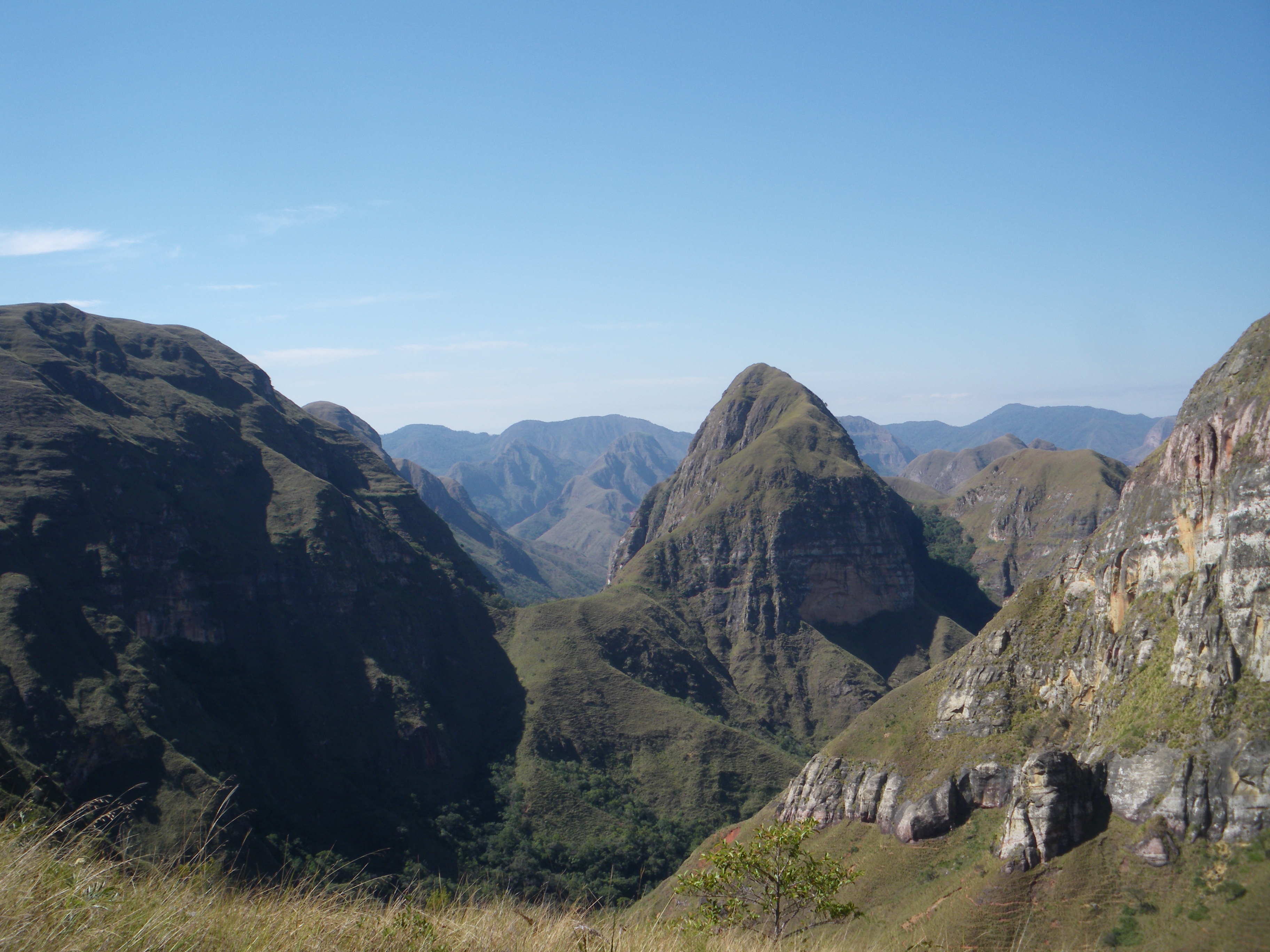
We decided to take a tour called “Bella Vista” (Pretty view) with RoadRunners and it turned out to be one of the highlights of our lengthy stay in Samaipata. We drove out of town for about an hour and then proceeded to hike up a high mountain (dubbed the “cathedral” by RoadRunners) with a flat top from which we would have a spectacular 360° view of the surroundings. The hike was not too taxing, but no picnic either and we sometimes had to walk in single file on a ridge too thin for two people to stand side by side, flanked by steep drops on either side. Not a good idea for people with a fear of heights.
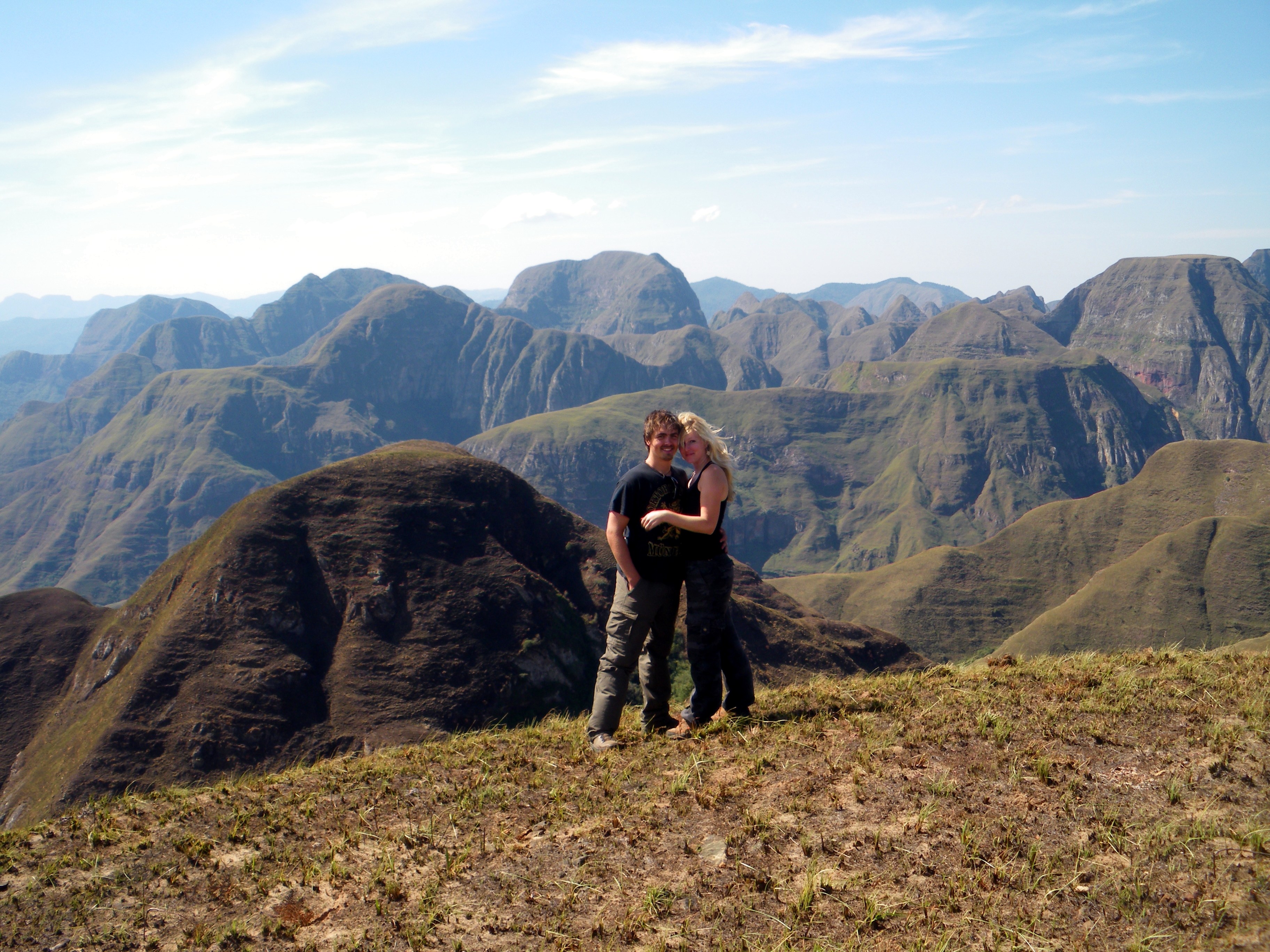
We were blessed with good weather and the views were spectacular, getting better and better as we hiked to the top. From above you could see in all directions, up to the furthestmost edges of the Bolivian Andes, about 80 km away. We hiked down on the opposite side of the mountain we hiked up upon, eventually ending in a ravine covered in a forest with ferns, bromeliads, orchids and even two impressive tree ferns.
29 July, Condor Hike
The majestic (but truly ugly) Condor, with a wingspan of up to 3 meters, is the national symbol of Bolivia. It can cover a distance of hundreds of kilometers in a day, conserving its energy by gliding on air currents. Near Samaipata is a cliff with a small inaccessible pool and waterfall, which attracts Condors from as far as Argentina and Peru, due to it’s secludedness and the fact that Condors cannot ascend straight from the ground up, but instead from the side of a cliff where the air currents can hold them up.
We hooked up with local guide Saúl, (a trained Biologist and owner of Tucandera tours) who accompanied Tony, Sofia, Manuela and I on a 16 km trek over the mountains to a lookout point where we could view the condors swooping down to the waterfall to bathe and drink.
We first took a taxi to a waterfall, called “La Pajcha”, and then to a point nearby were we started hiking up a mountain. Sometimes we would arrive, sweating and out of breath at a certain area, to find it littered with cow dung. This was something we already noticed on our Bella Vista hike and we were continuously amazed at the mountain climbing skills of the local cattle.
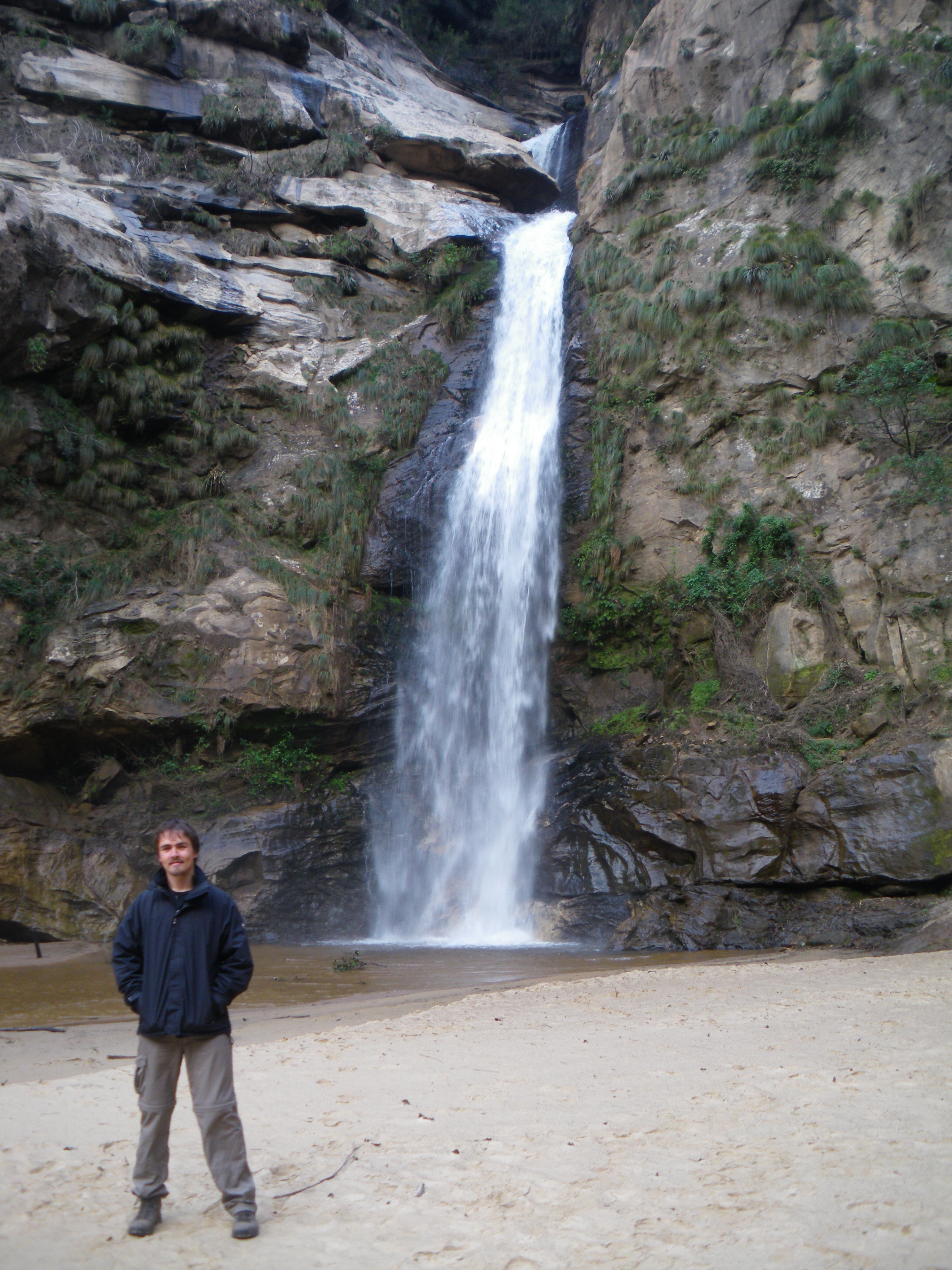
Saúl showed us some local fauna, including some aromatic flowers “Vira Vira” to make tea from (he was nice enough to pick some for us and we continued to make tea for the following two weeks) and a plant with which the local indigenous woman induce abortions (and risk their own lives or nervous systems). We saw condors quite early on, including one very rare (for the area) tropical condor, but we could not have known the spectacle that awaited us when we reached the cliff. There were about 6 condors visible at the top of the waterfall, and we made turns using Saúl’s binoculars to get a better view. Every few minutes, a solitary or pair of condors would appear on the horizon, to swoop down into the canyon and land on the cliff on top of the waterfall. It was an amazing site to behold, and, for lack of an expensive camera, we had to be content with taking it all in being in the moment. We saw about 25 condors in total and the day turned out to be one of the highlights of our entire South American trip.
We were warned beforehand that too many tourists might disturb the birds, and we made sure not to get too close, even declining to go to another lookout when our guide offered. In the end, we stayed a good distance, saw two dozen condors and had the time of our lives staring out into the expanse of the large condor filled canyon in front of us.
30 July, El Fuerte
The original Samaipata, a pre-Incan settlement, was located next to a large slab of sandrock. The sandrock was carved out at the top and at the sides, in what appears to be for ritualistic purposes. The Incas later arrived and continued to carve out symbolic shapes with Jaguars and Condors, and three twenty four meter long channels with symbolic snake carvings, used for liquid sacrifices. In the middle is a round circle with alternating seats for high priests and spirits. At the sides are niches that were covered in gold and contained urns with the mummified remains of important people.
Today, Samaipata is located in a valley, and this original settlement is now only known as “El Fuerte” (the fort). El Fuerte was the eastern most fronteir town of the Incan empire and therefore of particular importance to them, (much more important than Machu Picchu apparently) as can be seen by the length of the snake canal, which is much longer than a similar one in Cusco. Theories abound as to the significance of the site. Some years ago, an Austrian scientist studied the site, and found water rising out of holes in the rock (though to be used for sticking in poles for building structures). The theory arose that the sandrock might in fact contain limerock, that acts as a sponge and collects rainwater through the sandrock, only to release it again at a later stage. Upon witnessing this phenonemon, the original inhabitants considered the site sacred, and built a temple to pray and sacrifice to the spirits to provide them with water from the rock.
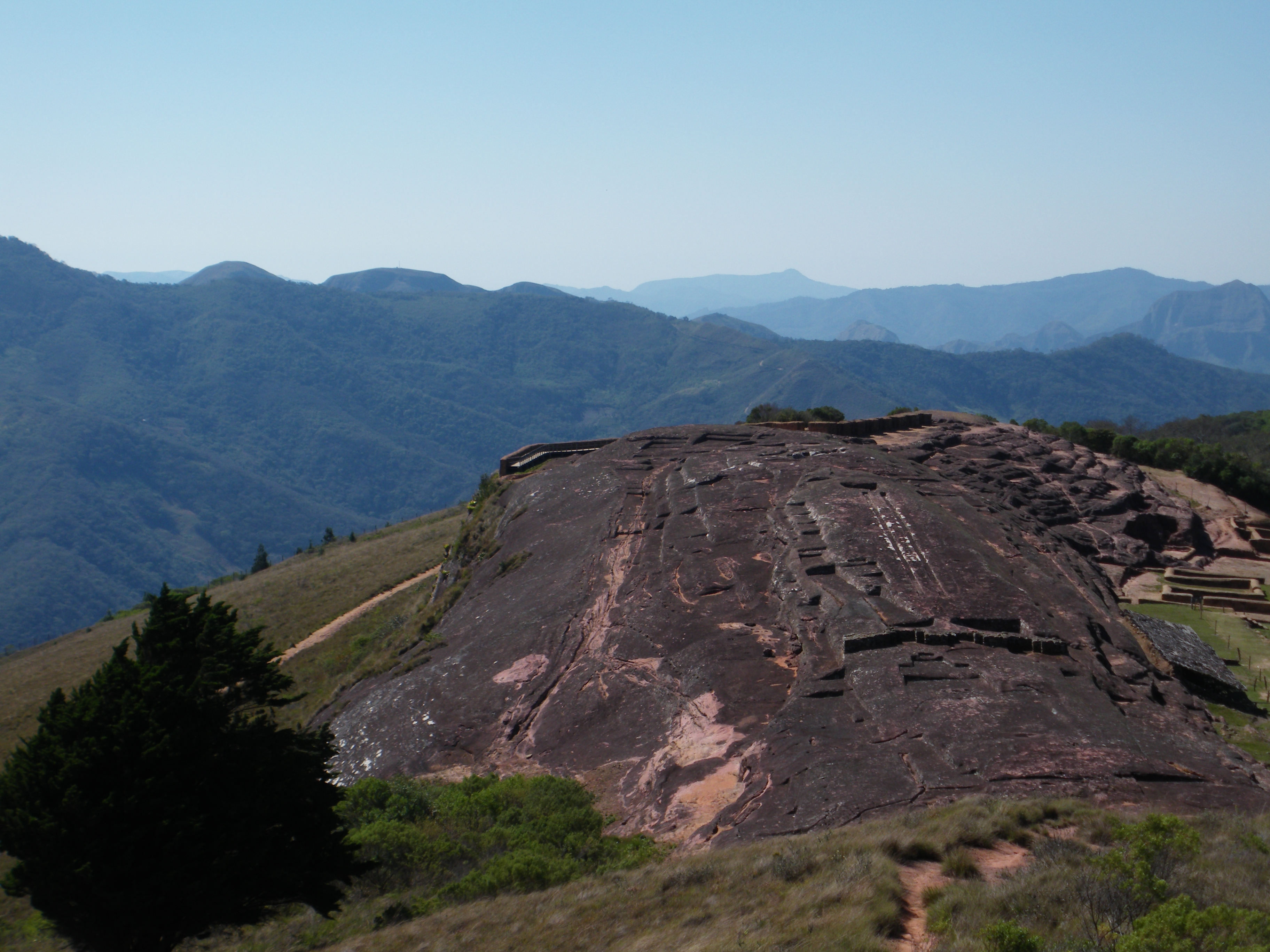
We again took the tour with Olaf from Roadrunners, who told us lots of amazing stories about the Incas, the Spanish conquistadores and an incredible coincidence that made an army of 40 000 warriors flee from 160 conquistadores headed by Pisarro.
Unfortunately the sandrock of El Fuerte is very soft and subject to a lot of erosion. So far the authorities have not done anything to combat this, and if left unchecked, some of the carved out features might be already be gone in 15 to 20 years.

31 July, Cloud forest in Amboro National Park
Samaipata is located close to the Amboro National Park, an area of about 100km by 120km with a large section in the middle completely off limits to visitors. Located inside Amboro at the top of a mountain range is a cold rainforest, the so-called cloud forest. The name arising from the fact that it’s so high that it’s mostly covered in clouds.
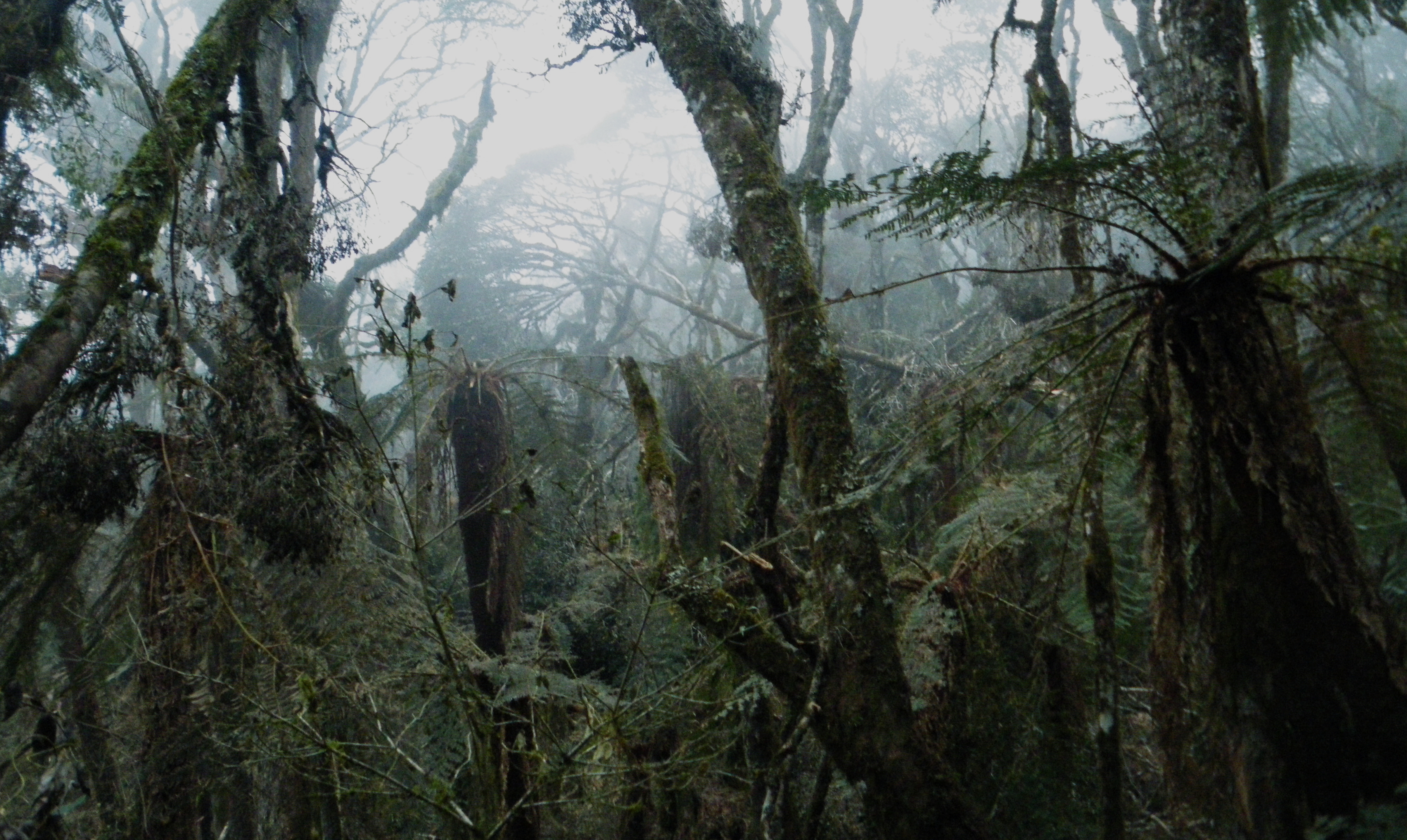
This was our last activity in Samaipata, and we went out one last time with Olaf to go and hike up to the cloud forest. Three weeks earlier, there was heavy snow in the area (for the first time in 50 years) and the cloud forest suffered a lot as a result, with many branches breaking, trees falling down and the big tree ferns losing their leaves. The hiking path was also partly destroyed and we would have to do some machete work here and there to clear a path.
It was however still an amazing experience walking through a forest covered in clouds, seeing trees covered in ferns, moss and lycans and smelling the mist in the air.
We can definitely recomend RoadRunners to anyone intending to visit Samaipata. Olaf and the gang were very helpful, friendly and honest and after three outings with Olaf we were all a bit sad to say goodbye.
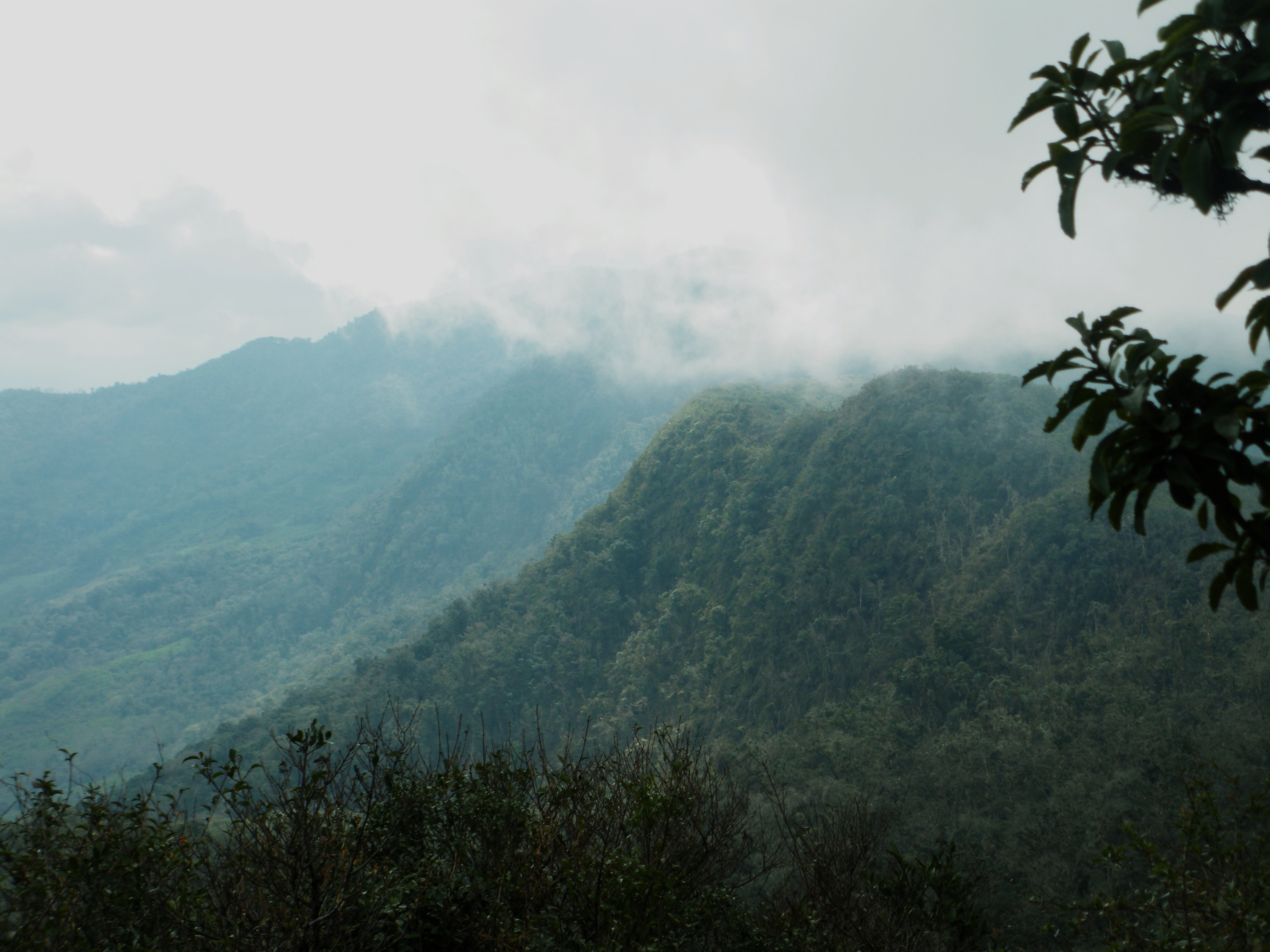
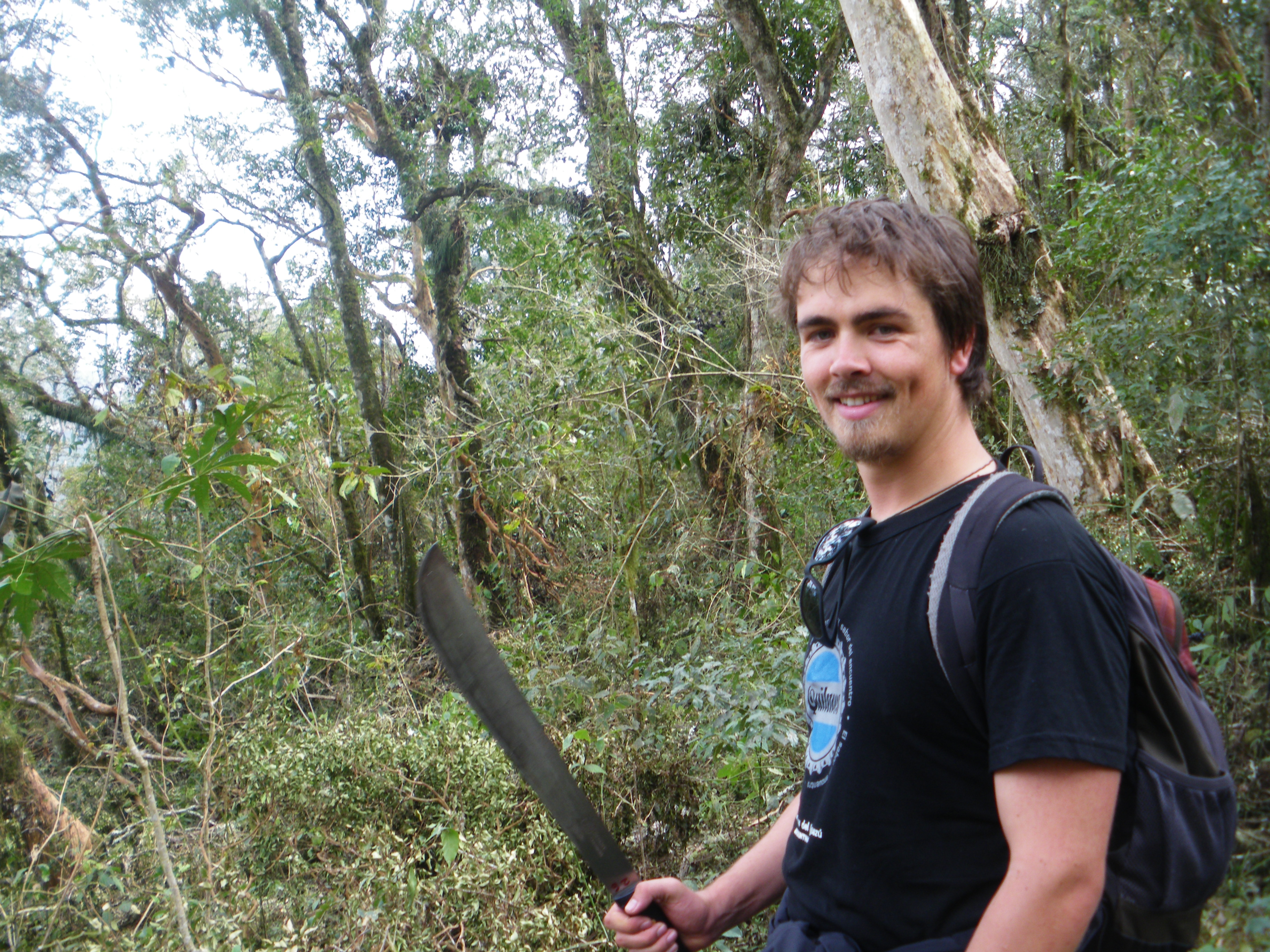
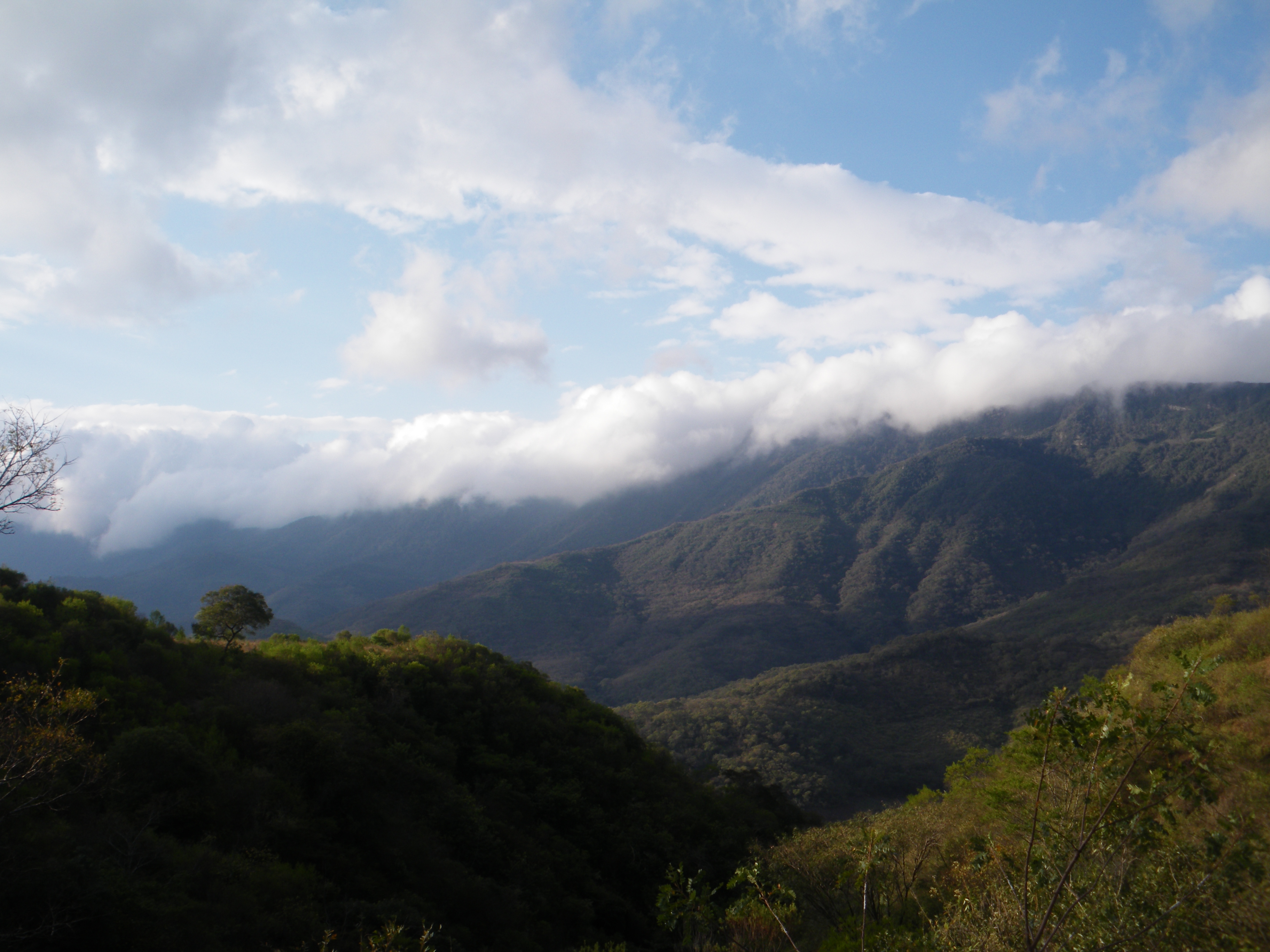
1 August, Finishing Che Guevara
This was our last day in Samaipata before leaving for Sucre and I spent most of the day finishing reading the biography of Che Guevara that Olaf lent me. I was finished with about two hours to spare before our bus arrived and was glad to have received some insights into the man whose famous image adorns Cuban money, posters, flags and the t-shirts of clueless teenagers and students everywhere in the western world.
Che definitely had some admirable qualities, but he was also a fanatic Marxist and a cold-blooded killer and guerilla fighter. I find it the hight of irony that his image adorns the t-shirts of youths from the very same capitalist countries he so despised. Just as I have once before realised with regards to the selling of religious relics, I was again aware how almost nothing is sacred or taboo when it comes to selling on the open market of capitalism, even if it is the image of a man who died fighting against that very same idea.
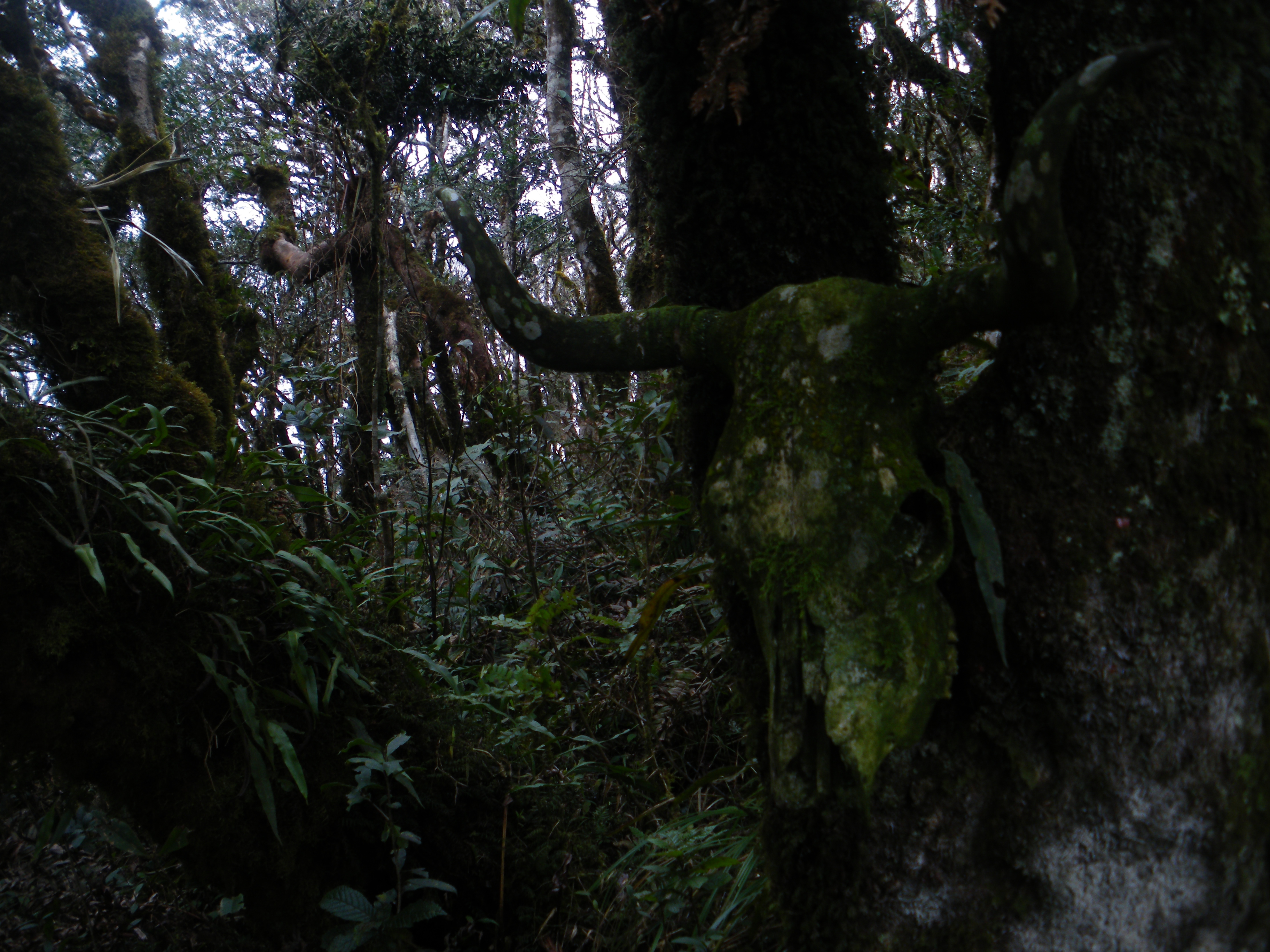
Hello, I'm JC Brand, software developer and consultant.
I have decades of experience working with open source software, for governments, small startups and large corporates.
I created and maintain Converse, a popular XMPP chat client.
I can help you integrate chat and instant messaging features into your website or intranet.
Don't hesitate to contact me if you'd like to connect.




